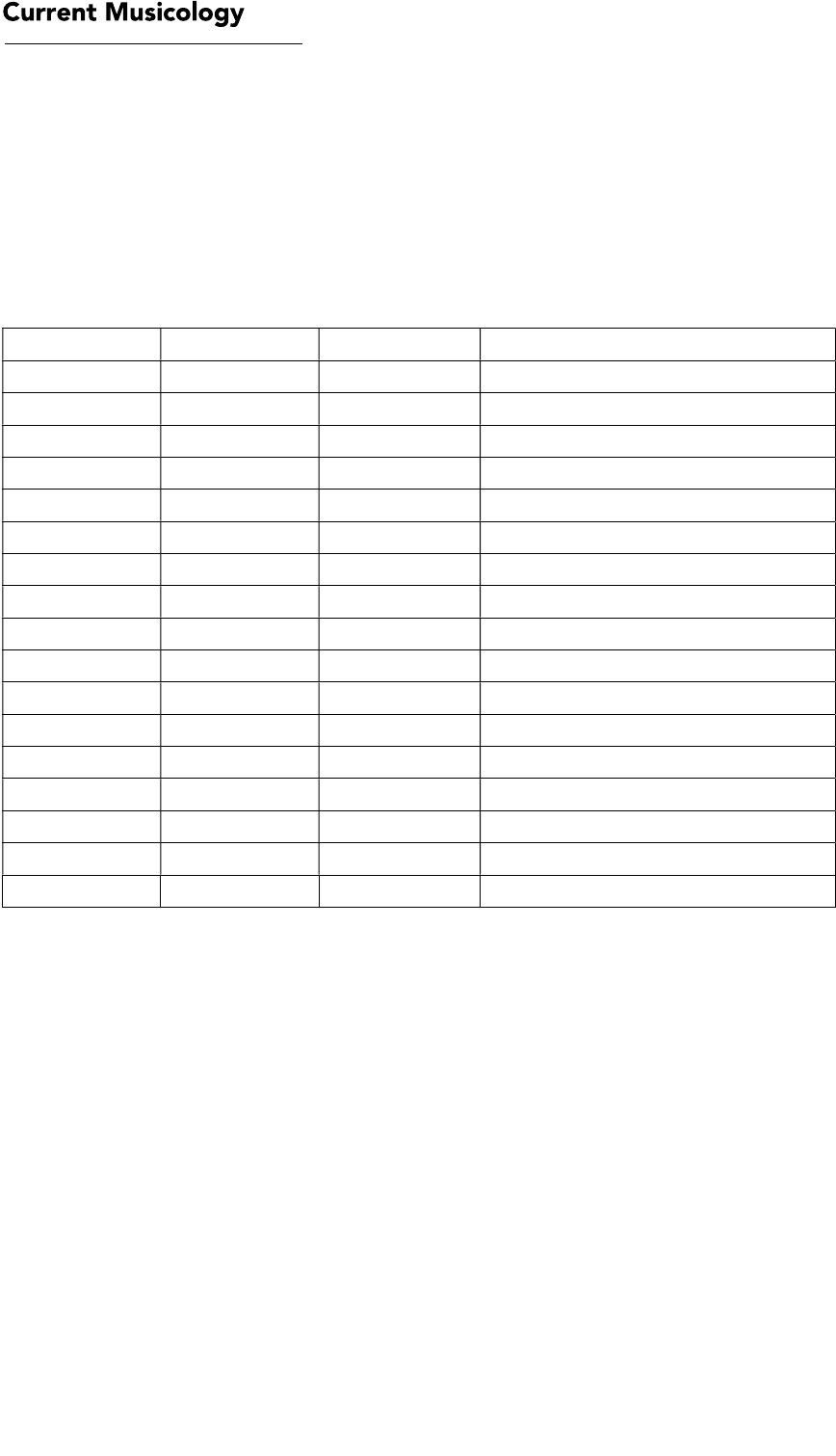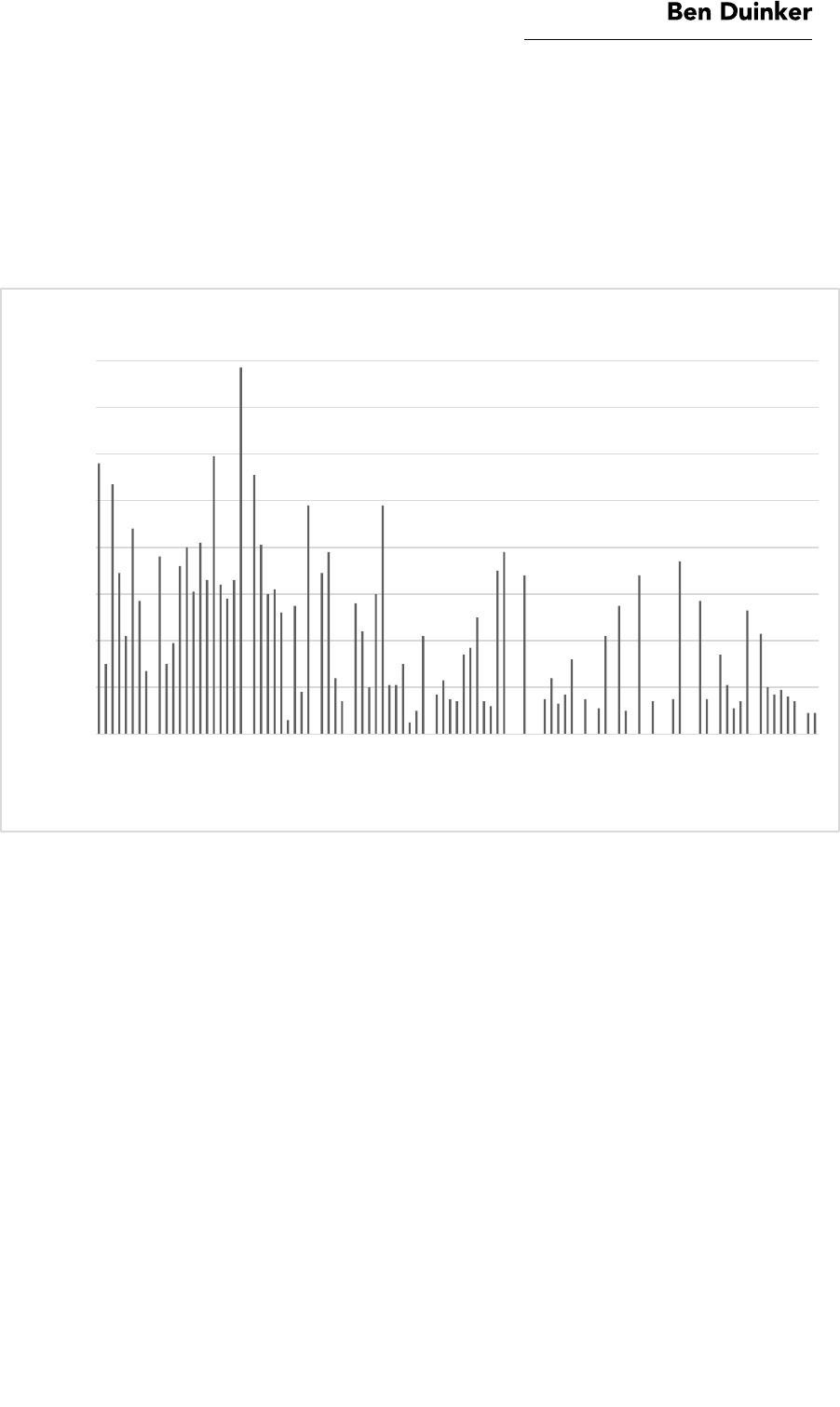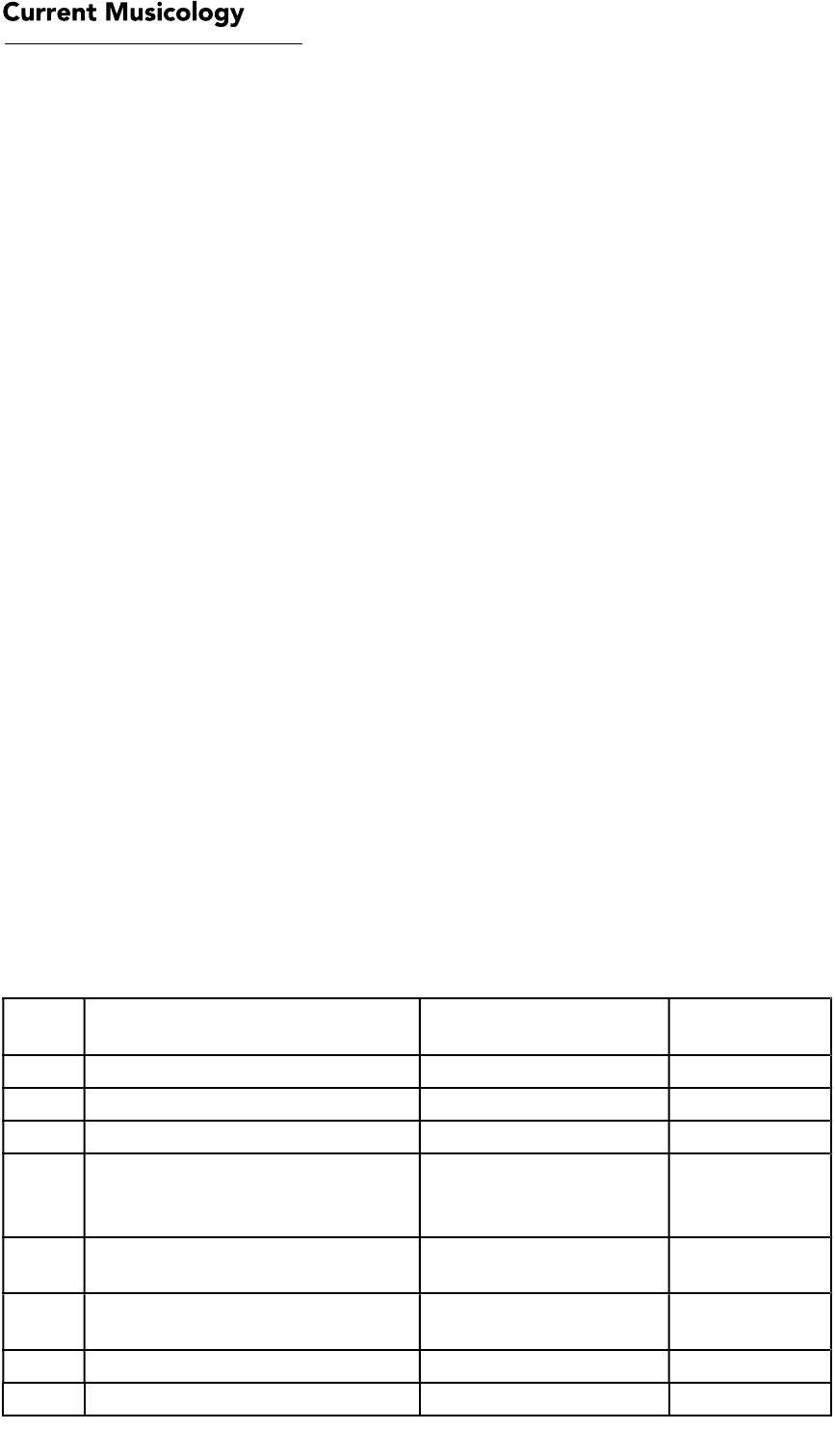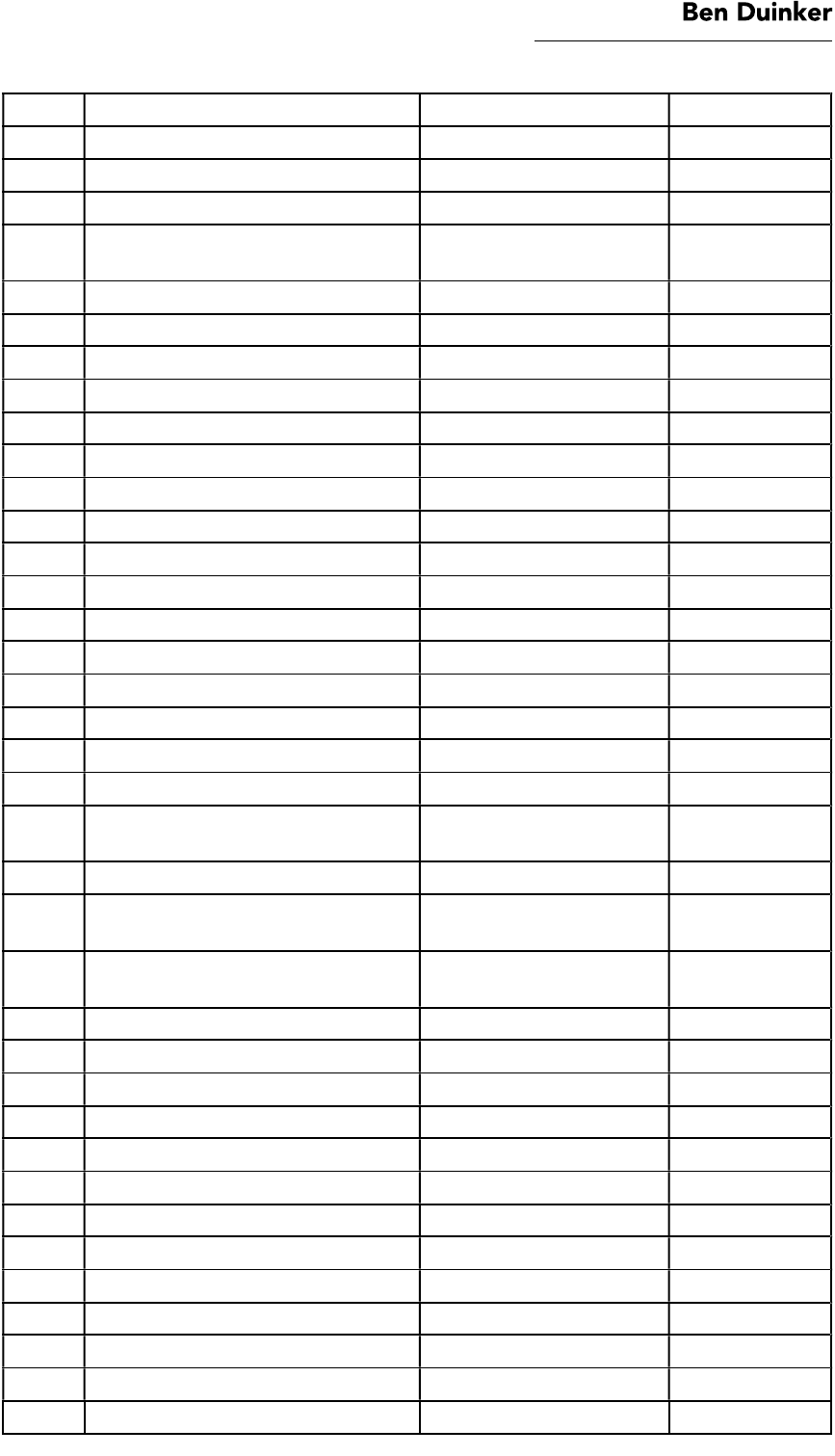
Current Musicology 107 (Fall 2020)
©2020 Duinker. This is an open access article distributed under the terms of the Creative Commons-Attribution-
NonCommercial-NoDerivatives License (CC BY-NC-ND).
93
Ben Duinker
Introduction
Ahmir “Questlove” Thompson—record producer, drummer for The Roots, and
bandleader for The Tonight Show—remembers exactly where he was the day
“Rapper’s Delight” (Sugarhill Gang, 1979) first received radio play.
1
In his
memoir Mo’ Meta Blues (2013), Thompson recalls wondering whether he should
remain in front of the radio to listen, or race for a cassette tape to record as much
of the song as he could. He opted to grab the cassette, recalling that “[the song]
sounded like it might go on for another five or six minutes” (23). Thompson’s
gamble paid off: the song did go on for a while longer, and he was able to record
some of it. The original 12” single of “Rapper’s Delight” runs for an astounding
14 minutes and 36 seconds, making it one of the longest songs to ever chart on
the Billboard Hot 100.
While few have been anywhere close to as long as “Rapper’s Delight,”
charting hip-hop songs have used a variety of formal sequences, some of which
substantially differ from the verse-chorus paradigm that has pervaded various
popular music genres since the 1960s. Salt-n-Pepa’s 1987 hit “Push It” peaked at
number 19 on the Billboard Hot 100. This song features lengthy ad-lib vocal
sections and instrumentals while squeezing in two verses almost as an
afterthought. More recently, Kanye West and Jay-Z’s collaboration on “Otis”
(2011) earned them a Grammy Award and substantial chart success; this song is
strophic (it lacks chorus sections), a formal paradigm that has all but disappeared
from popular music.
2
“Rapper’s Delight” was released in hip-hop music’s
nascency—no formal “norms” existed yet, at least not in the recorded medium.
“Push It” emerged during the genre’s so-called Golden Age, when
experimentation was generating a flourishing stylistic diversity in hip hop. And
“Otis” came out when hip-hop music was on its way to becoming synonymous
with mainstream popular music: inter-generic permeability was becoming—and
remains today—the norm.
3
Over time, the formal structure of hip-hop music has
become consolidated in the verse-chorus image of mainstream popular music.
But how did hip hop’s formal conventions evolve—from “Rapper’s Delight” to

94
the present day—and what can this evolution tell us about the mainstreaming of
this genre?
This paper explores the evolution of song form in North American
recorded hip-hop music, tracing the genre’s origins as a live musical practice,
through its commercial ascent in the 1980s and 1990s, to its ubiquity in—and
dominance of—mainstream popular music in the twenty-first century. I conduct
an analytical study of form across 160 hip-hop songs (see the appendix) released
since 1979 to support the three main contributions of this paper. First, I offer a
taxonomy of song section types, investigating how texture, timbre, lyrics, and
singing function as the main agents of formal sectionality in hip hop. I codify
two principal section types, verse and hook (similar, but not identical to a chorus
section), and two looser-defined section types, instrumental, and loose-vocal,
using song examples to illustrate each section type and to discuss these sections’
musical function and/or origins in live performance practice.
Second, I present three formal paradigms that are built up from these four
section types, proposing that the form of many, if not most, hip-hop songs can
be described using one of these paradigms. I classify these as verse-hook, strophic,
and long verse. I evaluate how the paradigms reflect live hip-hop performance
practice (including battling, hyping, and the cypher) and its antecedents: the live
hip-hop performances of 1970s New York (which gave rise to hip-hop music)
and the African American oral tradition of toasting (long, recited poems). In
doing so, I propose a viewpoint that considers hip-hop form through the cultural
underpinnings of this genre, rather than in the image of song forms used in other
popular music genres.
Finally, I investigate how a gradual shift in focus toward verse-hook songs
can be understood in relation to hip-hop music’s ongoing mainstreaming. I
propose three metrics to gauge this shift in focus: the emergence of hooks as a
distinct section type, the rise in popularity of sung hook sections (including by
guest artists), and the specific characteristics of hook sections: their quantity,
their point of first arrival in a song, and their proportion of the song’s total
duration. Viewing hip-hop music’s development through the lens of song form
thus represents both its roots in African American vernacular culture and
assimilation into mainstream popular culture; following blues, R&B, rock ‘n’ roll,
soul, and other genres in traversing this path.
Hip hop’s crossover has been discussed from a variety of perspectives.
Nelson George (1988) and Mark Anthony Neal (2005) have written about the
schism that occurred in the 1980s whereby some Black artists became massively
successful through their new appeal to white mainstream audiences (such as

95
Michael Jackson or Lionel Richie) while alienating their earlier—mostly Black—
fanbase. Amy Coddington (2018) has explored the role of radio producers as
tastemakers in cultivating a divide between the pop-rap of MC Hammer and
Vanilla Ice and the underground music of A Tribe Called Quest and other
Golden-Age artists. Murray Forman (2002), Roni Sarig (2007), and I (2019) have
each investigated the vanishing idea of space and place in hip-hop music as it has
become increasingly mainstreamed. And numerous others, among them Jeff
Chang (2005) and Loren Kajikawa (2015), have noted the increasing
consumption of hip-hop music by white audiences.
4
My aim is to build on this
discussion of hip-hop’s mainstreaming by focusing on song form; more
specifically, the ever-expanding role of the hook section in hip-hop music. The
hook’s increasing prevalence, its earlier placement in song forms, and its
incorporation of singing all evince hip hop’s subsumption by mainstream pop
music.
Song Sections and their Functions
Hip hop is like most other popular music in that its formal sections are ordered
in a song to imbue it with variety, contrast, and some degree of trajectory. I
characterize song sections in hip hop by whether they participate in the core
sequence of a song, or function as framing areas to this core. The core sequence
of a song normally involves verses and hooks, but may also include instrumental
or bridge-like sections. Framing areas normally involve sections with looser
organized vocals (such as ad-hoc “hype” vocals) or instrumental sections. The
main difference between the core sequence and its framing areas concerns the
tightness of sectional organization: core sequences are normally the more tightly
organized of the two.
5
Research on form in popular music has grown substantially since 2000,
but almost none of it explicitly deals with hip-hop music.
6
Corpus studies by Jay
Summach (2012) and Jeffrey Ensign (2015) study song form in a broader array
of popular music—using Billboard charts as corpus sources—but such charts
have traditionally excluded hip-hop music.
7
Scholarship on form in popular
music has expanded to include specific formal paradigms (Spicer 2004, Osborn
2013), artist-specific research (Covach 2006, Stephan-Robinson 2009), song
sections (Attas 2015, Summach 2011), and genres such as EDM (electronic dance
music) (Iler 2011, Osborn 2019, and Barna 2020). Research on form in EDM sets
important precedents for the present study. First, EDM songs are composed to
create and moderate the flow of energy on the dance floor; the formal design of

96
this music does not always lend itself well to the context of radio play.
8
EDM’s
practical function as a dance-oriented music resonates strongly with early hip-
hop music, whose main context of dissemination was at dance-infused
gatherings. Second, EDM song forms rely more on musical parameters such as
texture and timbre, and less on melody and harmony. This again suggests
parallels with hip-hop music, which has traditionally foregrounded aspects of
texture, rhythm, and timbre.
9
The above scholarship provides a blueprint for how a bottom-up (rather
than top-down) study of form in hip hop might look: a taxonomy and
description of song section types according to their internal characteristics, an
examination into how these sections function in a complete song, and whether
any formal paradigms arise. Nearly all hip-hop songs feature some combination
of verses, hooks, and instrumental sections, and share similarities with formal
paradigms used in other popular music. Although I define these section types
according to their internal musical and lyrical characteristics, their functionality
or “effect” they express to the listener (after Doll 2017, 8–9) in songs can vary.
10
In general, verse and hook sections conform to specific musical and lyrical
criteria and express consistent functionality within a song, while instrumental
and loose-vocal sections are less standardized in their content and
functionality.
11
Verse
Verses have been a constant fixture in recorded hip-hop music since its
inception; they facilitate the song’s main narrative arc (if one exists) or provide
commentary on the song’s thematic topics. As in popular music, hip-hop verses
are usually “lyrically variant but musically invariant” (Ensign 2015, 27), meaning
that each successive verse utilizes new lyrics and flow rhythms over the same
beat. Michael Berry (2018) writes that the 16-measure verse has become the
standard length in hip-hop music.
12
The ubiquity of even-numbered verse
lengths is unsurprising: since rhymes normally punctuate the ends of measures
and rhymes are often patterned in couplets, it follows that the mensural length
of most verses will be a multiple of two.
13
Although even-numbered verse lengths
may be common, my data suggests that they also vary widely in length.
Berry also notes that the beat layer (what he calls “the music”) typically
remains unchanged across a verse, often repeating a looped sequence that may
be one, two, or four measures in length (and occasionally longer).
14
Exceptionally, the beat layer’s texture can also gradually change or intensify

97
through the course of a verse. It may also contrast the musical texture of the hook
section, drawing another similarity to other genres of popular music. Example 1
demonstrates some of these characteristics in the beat for “Hard Piano” (Pusha
T, 2018), where textural elements are periodically introduced and removed. The
piano/drum sample from “High as Apple Pie – Slice II” (Charles Wright and the
Watts 103
rd
Street Rhythm Band, 1970) is supplemented first by a drum machine,
and then by a synthesizer-generated chord progression.
Example 1: “Hard Piano” (Pusha T, 2018). The excerpts above detail the different textural
layers that are introduced during the introduction and first verse of the song.
Hip-hop verses are forums for MCs to orate, narrate, display musical and
lyrical dexterity, and connect with listeners. Their varied length, quantity, and
rhythmic and lyrical content may reflect a number of a priori factors: how they
were composed and recorded in-studio, how a live-based performance practice
influenced their construction, or what demands (often commercially driven)
were imposed by record labels or other industry actors. Consider, for example,
“Roxanne’s Revenge” (Roxanne Shanté, 1984) and “NY State of Mind” (Nas,
1994). Both songs feature exceptionally long verses, which may signal looser
organization than in songs with consistent 16-measure verses. But these long,
irregular verses make more sense when considered in the context of how they
were recorded. Shanté allegedly recorded “Roxanne’s Revenge” completely

98
freestyle (unrehearsed and uncomposed) and in a single take; a herculean feat
for any MC, much less a 13 (!) year old with no prior recording experience.
15
“NY
State of Mind” features two long verses of different lengths; but these were also
recorded in a single take.
16
The spontaneity that permeated the recording of these
verses arguably influenced their length: in Shanté’s case, the long duration, and
in Nas’s case, the variance in duration between verses.
Hook
Hook sections in hip-hop music are somewhat analogous to choruses in other
popular music genres: their lyrics usually remain fixed over the course of the
song, quote or hint at the song’s title, and often contrast the function of the verse
lyrics. Hook sections normally comprise a single, self-contained section, but two-
part hooks are occasionally used, such as in “Money Ain’t a Thang” (Jermaine
Dupri ft. Jay-Z, 1997), where the first part of the hook begins on the lyrics “In
the Ferrari” and the second part on “Y’all wanna floss with us.”
17
If the verse
involves narrative, the hook might comment on that narrative. In protest-based
songs, the verse may describe an issue while the hook incites a call to action.
18
Hook lyrics can be rapped or sung, and, until recently, the hook was normally
the sole location for singing in hip-hop songs.
19
I prefer to call these sections hooks (instead of choruses) because, while
their functional role may parallel choruses in popular music, they fulfill this role
in different ways.
20
I agree with Paul Edwards’s statement that hip-hop hooks are
“designed to ‘hook’ the listeners” (2009, 187) and propose that they do so
through a level of lyrical repetition and fragmentation not normally seen in
popular music—an extreme example would be “Gucci Gang” (Lil’ Pump, 2017),
where the title lyric is rapped no fewer than 20 times in each hook. Furthermore,
hip-hop hooks do not rely on many of Temperley’s features of chorus sections
(2018, 160), especially those concerning melodic and harmonic parameters as
well as formal ordering. Instead, hip-hop hooks—when defined against
characteristics of verses—are built on subtle textural shifts, the presence of
singing, sampled or instrumental riffs in the beat layer, and the aforementioned
fragmentation. While some songs feature sung hooks that sound remarkably
similar to a standard pop chorus—such as “Juicy” (The Notorious B.I.G., 1994)—
others feature incessant repetition of title lyrics, such as “93 Til’ Infinity” (Souls
of Mischief, 1993). Still others have hardly any lyrics at all, and an instrumental
motif assumes central importance, such as in “Grindin’” (Clipse, 2002).

99
In my taxonomy I call on several criteria for defining hook sections. First,
a hook section contains intelligible vocals—either sampled, rapped, or sung.
Second, these vocals usually reference the title of the song or are repeated and
fragmented.
21
Third, the hook section remains musically and lyrically invariant
throughout the song, usually (but by no means always) alternating with verses.
Another criterion of hook sections involves their textural distinction (I stop
short of conflating this with intensification or thickening) from the verses.
22
While many of these stylistic features are also ubiquitous in pop choruses, the
near-total lack of melodic and harmonic differentiation between verses and
hooks in hip-hop music, combined with the greater emphasis on fewer, more
repeated lyrics, warrants a separate definition of the hip-hop hook that
distinguishes it from the pop chorus.
23
Instrumental
Beyond verses and hooks, other song sections in hip-hop music are less
consistent in their content and functionality. While it might seem
straightforward to define instrumental sections by virtue of them lacking live-
performed vocals, their texture and musical content occasionally position them
well to function as hook sections. In this sense then, category and function
diverge for instrumental sections. These sections involve only the beat layer; no
live-performed vocals are present. The beat layer comprises a combination of
instruments, computer-produced sounds, scratching or other turntable-
generated sounds, and samples. Samples may involve vocals, and paradoxically,
instrumental sections may actually contain vocals by virtue of their participation
in the beat layer. But these vocals are unintelligible: they may be short fragments,
scat singing, or other brief utterances. If the vocal samples involve intelligible
lyrics, it is more likely they are imbuing the section with a hook-like quality, and
could thus be interpreted as hook sections.
Amanda Sewell writes that “lyric [vocal] samples have many different uses
and applications in sample-based music: layered against newly-rapped lyrics in
an adjunct function, scratched into a track’s introduction or an interlude
between verses, or substituted into a rapped lyric” (2013, 54).
24
Vocal samples in
an “interlude between verses” quite often contribute appreciably to the song’s
lyrics, either by referencing the song’s title or commenting on the song’s
narrative or theme in some way. Vocal samples may thus participate in
establishing the hook-like quality in a song section, especially when the vocal
samples reference the song title, such as in “Watch Me Now” (Ultramagnetic

100
MCs, 1988) or “Hold It, Now Hit It” (Beastie Boys, 1986). By contrast,
unintelligible vocal samples carry less potential to imbue such hook-like
qualities. In “It Ain’t Hard to Tell” (Nas, 1994), verses alternate with sections that
feature a denser beat-layer texture, a sampled saxophone riff, and sampled female
scat vocals. These sections are almost hook-like, but for their lack of intelligible
vocals I classify them as instrumental. These three songs expose an inconsistency
with how instrumental sections function: when they are positioned between
verses, their internal content—especially vocal samples—may cause them to
express hook-like qualities of varying strength and salience.
The opening thirty seconds of “Watch me Now” illustrate this blurry
boundary by juxtaposing different types of vocal samples. The first 18 seconds
contain numerous whoops and cries originally performed by James Brown; some
of his signature vocal gestures.
25
But these vocal samples are unintelligible as
lyrics, and thus help define this introduction as an instrumental section (0:00–
0:18). Immediately following this section, the “Watch me Now” sample (from
“It’s Just Begun” by The Jimmy Castor Bunch [1972]), imbuing the section with
hook-like qualities, helping define 0:19–0:27 as a hook (indeed, it is the “Watch
me Now” section that returns after each verse). By attending to the varied
intelligibility and narrative function that vocal samples may exhibit, I thus
interpret them as alternately contributing to instrumental or hook sections. The
looser-knit nature of instrumental sections and their variegated placement
within song forms suggests a wider array of functional purposes for them,
including dancing, repose from the vocals of the verses and hooks, and a space
to showcase the musical contributions of DJs and beat producers. Indeed, hip
hop’s earliest musical manifestations showcased beats, along with their creators;
rapping came later.
Looser-Organized Vocal Sections
Live-recorded vocals in hip-hop music are not restricted to verses and hooks:
looser-organized sections may contain ad-hoc, ametric vocals, skits, or may
simply involve rapping or singing in a section that does not function like a verse
or hook. Many songs feature ad-hoc vocals that characterize sections in their
framing areas, but less often within the core sequence. These ad-hoc vocals
occasionally function as “hype” vocals: ametric vocals that usually serve the
rhetorical purpose of enhancing anticipation of the song’s main lyrical content.
A prominent example of hype vocals in hip-hop music can be found in the music
of Public Enemy, where group member Flava Flav effectively functions as a “hype

101
man.”
26
Other ad-hoc vocals might be less hype-based and more about
connecting directly with listeners or other artists. These may include “shout out”
sections (normally at the end of songs) or more introspective lyrics performed in
an ametric fashion, such as when Anderson .Paak discusses his personal finances
(0:50) in “CUT EM IN” (2020). Ad-hoc vocals are noticeably more common in
hip-hop music than they are in other popular genres. They are so common, in
fact, that this type of vocal also appears within and throughout verses and hooks
(a notable example being producer Sean Combs’s frequent vocal injections in the
rapped performances of Notorious B.I.G.). This prevalence likely has much to
do with hip hop’s origins as a live musical genre centered around the DJ (who is
now commonly referred to as the producer). The outdoor hip-hop parties of
1970s and early 1980s Bronx and Queens featured the DJ as performer; any
vocalizing was usually done by the DJ, or in deference to them.
27
This vocalizing
was not the main focus and was ad-hoc or spontaneous in nature. As hip hop
established a tradition of recorded musical output, the hype/ad-hoc vocals
remained a central part of some artists’ personal styles.
28
As can be seen from the
aforementioned types of looser vocal practices in hip-hop music, loose vocal
sections are highly variegated and serve a variety of different musical functions.
I have established flexible descriptions of four main types of song section
in hip-hop music. This framework allows for a systematic encoding of song
forms across a large corpus of repertoire. These encodings in turn reveal several
prevailing formal paradigms in hip-hop music. The next section explores these
paradigms, proposing some possible locations and trajectories for their
development.
Formal Paradigms
To better understand how sections combine to create whole songs in hip hop, I
draw on a recent corpus study where I analyzed 160 songs released between 1979
and 2017 (Duinker 2020). This corpus was generated from two source lists:
Rolling Stone’s “100 Greatest Hip-Hop Songs,” and the Grammy Award category
for Best Rap Song. While my main analytical goal was to investigate aspects of
rhythm and meter, I also annotated each song’s form by section type and
duration. Example 2 displays my annotation method for the song “Hate It or
Love It” (The Game ft. 50 Cent, 2005). “Hate It or Love It” begins with a nine-
second ad-lib vocal section followed by a series of verses and hooks performed
by the song’s two MCs, The Game and 50 Cent. From 2:53 until the song’s
conclusion, the beat layer continues with no vocals from either MC—there is,

102
however, a female vocal sample embedded in the beat layer that does not
contribute appreciably to the song’s lyrics. I have thus encoded this final section
“instrumental.” The annotation of “Hate It or Love It” reveals a commonality in
hip-hop form: hook sections are typically the same durational length across an
entire song, while verses are more likely to vary in length.
Formal Region Section Type
Elapsed Time Duration (s) Notes
framing area voc 0:00 9 50 Cent (hype vocals)
core sequence
vs1
0:09
28
50 Cent
hk 0:37 21
vs2 0:58 37 The Game
hk 1:35 20
vs3
1:55
38
50 Cent and The Game
hk 2:33 20
framing area inst 2:53 33 includes fadeout
Example 2: Formal annotation for “Hate It or Love It” (The Game ft. 50 Cent, 2005). Section-
type abbreviations are used as follows throughout this paper: voc = loose vocal section, hk =
hook, vs = verse, and inst = instrumental. All sectional durations documented here should be
interpreted +/- one second: durations were calculated from real-time elapsed time
measurements, meaning slight inaccuracies in the order of one second were common.
The song’s form is straightforward: “Hate It or Love It” features discrete
framing areas and a tangible core sequence of verses and hooks. But many other
songs exhibit more irregular forms. Consider the original 12” release of “Push It”
(Salt-n-Pepa, 1987), whose form is annotated in Example 3. The song’s first verse
appears at 1:31—this is quite late for a first verse—and besides a few other verses
and hooks, the remainder of the song is loosely organized: the entire duration
leading up to the first verse, for example, is an amalgam of instrumental passages,
hype vocals, and chanting. No clear sectionality emerges here, yet no one section
type (of my four) is clearly established. I have therefore chosen to denote this a
hybrid of instrumental and looser vocal section types (hence “inst/voc” in the
annotation). Such hybrid sections appear to be common in framing areas, but
their outsized presence as in “Push It” (the framing areas make up 60% of the
song’s duration) is rare. As a party-oriented song, “Push It” features these
extended loose sections primarily to aid the song’s danceability.
29
“Push It” thus
reveals the importance of considering performance context and function of
songs when evaluating the sectionality of their forms.

103
Formal Region Section Type
Elapsed Time Duration (s) Notes
framing area inst / voc 0:00 91 features hype vocals
core sequence vs1 1:31 16
hk 1:47 13
inst / voc
2:00
27
vs2 2:47 12
hk 2:59 16
framing area inst / voc 3:15 77 includes fadeout
Example 3: Formal annotation for “Push It” (Salt-N-Pepa, 1987). The “inst/voc” sections are
so named for their hybridity—they integrate aspects of instrumental and loose vocal section
types—and are notable in their comparatively long duration.
The remainder of this section is organized around three prevailing formal
paradigms: strophic form, verse-hook form, and long-verse form.
Strophic Form
Strophic-form songs generally feature a core sequence comprising multiple
verses that either proceed in immediate succession or are interspersed by
instrumental interludes. Such interludes typically lack hook-like qualities.
Example 4 provides a general schema for strophic forms in hip hop. Notable in
strophic-form songs is the near-total absence of hook sections; in this way,
Example 4: General schema for strophic-form songs. These songs typically include a core
sequence that is bounded by framing areas. The core sequence may include a succession of
verses (upper diagram), or a succession of verses interspersed by instrumental sections (lower
diagram).
Core SequenceFraming Area Framing Area
VerseIntro OutroVerseVerse
Core SequenceFraming Area Framing Area
VerseIntro OutroVerseVerse
Instrumental Instrumental

104
strophic form is quite similar to Covach’s “simple verse form” (2004, 73).
30
The
long single version of “Rapper’s Delight” (Sugarhill Gang, 1979) constitutes a
textbook example of strophic form. An instrumental section begins and
concludes the song, framing the core sequence of four verses rapped in
immediate succession.
31
“King of Rock” (Run-DMC, 1985) follows a slightly
different trajectory. With no introductory framing area, the first verse begins
immediately at the song’s outset. The eight verses of this song are always followed
by instrumental sections of varying lengths, laden with rock guitar soloing; the
alternation of these sections makes “King of Rock” a strophic-form song.
While parallels can be drawn between the strophic-form hip-hop songs
and the “simple verse” and “AAA” forms used to describe other popular music,
I hesitate to use such parallels as a defining characteristic of strophic hip-hop
songs. I prefer instead to contextualize strophic form in the tradition of live hip-
hop performance. An important aspect of hip hop’s performance tradition is the
cypher: an informal group-performance context where various MCs take turns
freestyling either atop a DJ-produced or beatboxed beat, or a cappella.
32
Michael
Newman describes cyphers as involving “improvised round-robin rapping”
(2005, 401), while H. Samy Alim qualifies them as “highly competitive lyrical
circles of rappers” (2006, 6). James Braxton Peterson (2014) and Roderick
Pullum (2019) have suggested that the term “cypher” emerged into common hip-
hop parlance through the influence of the Five-Percent Nation.
33
Though cyphers typically have no set requirements regarding the number
of MCs participating or the length of their verses, the general form they follow
involves the introduction of a beat followed by a succession of freestyle verses,
rapped by different MCs. The musical and lyrical foci of cyphers are intertextual
references, unifying chains of rhymes, and communication between MCs in the
cypher (such as calling one another by name to spit the next verse, or through
put downs). Hooks generally play no important role in cyphers. While the cypher
is a less formal, live performance practice, its analogy in recorded hip-hop music
can be seen through the “posse cut,” which is a song that features different
rappers (usually associated with one another, occasionally through a common
record label) on each verse. Several well-known posse cuts appear in the corpus,
“Scenario,” “The Symphony” (Marley Marl et al., 1989), “Flava In Ya Ear
(Remix)” (Craig Mack et al., 1995), and “Fuckin’ Problems” (A$AP Rocky et al.,
2013) among them.
34
“The Symphony” represents perhaps the truest
resemblance to a cypher of these posse cuts: a brief intro featuring Marley Marl
is followed by successive verses rapped by Masta Ace, Craig G., Kool G Rap, and

105
Big Daddy Kane, respectively, each MC concluding his verse by naming the next
MC who is due up to rap.
By drawing parallels between cyphers, posse cuts, and strophic form, I aim
to show that, in live hip-hop performance practice, the lyrical, structural, and
musical focus of the song is often centered around the verse. Verses are what
cyphers and rap battles (another chief format for freestyling) are made of. Verses
figure prominently in strophic hip-hop songs. And verses are the platform across
which a collection of MCs come together to contribute to posse cuts. The verse—
however it is structured—is the main conduit of communication and exchange
in hip-hop performance, and its centrality to the cypher, posse cut, and strophic-
form song traces a through-line between these practices.
Verse-Hook Form
Verse-hook form chiefly involves what its name suggests: verses and hooks. The
general schema of verse-hook form is detailed in Example 5. Like the verse-
chorus paradigm referenced by Covach (2004), Temperley (2018), Ensign
(2015), and others, verse-hook songs in hip hop feature a core sequence of
alternating verse and hook sections. This sequence occasionally includes
instrumental or loose-vocal sections, but my corpus data suggests that such
interventions are uncommon. Rarer still are verse-hook songs where multiple
verses or multiple hooks (these could perhaps also be characterized as two-part
hooks) occur in immediate succession.
Example 5: General schema for verse-hook songs. The chief variable in these songs involves
the ordering of verses and hooks, as shown between the two formal trajectories above.
Core SequenceFraming Area Framing Area
VerseIntro OutroVerseHook
Core SequenceFraming Area Framing Area
VerseHook
Hook
VerseHookIntro Outro

106
Three songs encapsulate these various affordances of verse-hook form. In
Example 6a, the formal sequence of “99 Problems” (Jay-Z, 2003) constitutes a
textbook example of a verse-hook form. A brief a cappella rapped introduction
previews the hook lyrics, before the core formal sequence runs through three
verses, each followed by a hook.
35
The song concludes with an instrumental
section—repeated iterations of the basic beat loop—complemented by various
hype vocals.
By contrast, “Lose Control” (Missy Elliott, 2005), shown in Example 6b,
features loose-vocal framing sections (mainly featuring hype vocals by Fatman
Scoop) and a core sequence that contains two pairs of verses and hooks. Loose
vocal sections occur after the first hook and again after the second verse. The first
of these features guest artist Ciara in a rapped/sung performance: more metric
than hype vocals normally are, but less tightly organized than Elliott’s verses and
hooks. The second loose vocal section features a repeated chant-like
performance by Elliott and Fatman Scoop.
36
Finally, the radio edit of “Ladies First” (Queen Latifah ft. Monie Love,
1989) as detailed in Example 6c involves a verse-hook core form (with no
framing sections) that features a changing number of verses between each hook.
The four hook sections in this song appear at the opening, after verse 2, verse 4,
and verse 7, respectively. This means the song’s eight verses appear in groups of
two, two, and three. While “Ladies First” and “Lose Control” depart from the
schema shown in Example 5, the general alternation of verses and hooks in their
core sequences identify these songs as verse-hook forms.
Formal Region Section Type
Elapsed Time Duration (s) Notes
framing area
hk
0:00
6
features hook lyrics
core sequence vs1 0:06 40
hk 0:46 11 shorter than other hook
sections in the song
vs2 0:57 62
hk 1:59 20
vs3 2:19 52
hk 3:11 21
framing area inst / voc 3:32 23 hype vocals
Example 6a: Formal annotation for “99 Problems” (Jay-Z, 2003). This song features discrete
framing areas and a balanced core sequence of three verses and three hook sections. Within
the core sequence, the first hook section is notably shorter than the following two.

107
Formal Region Section Type
Elapsed Time Duration (s) Notes
framing area voc 0:00 18 hype vocals
core sequence vs1 0:18 32
hk 0:50 14
voc 1:04 17 rapped / sung
vs2 1:21 30
voc 1:51 16 chanting
hk 2:07 13
framing area voc 2:20 87 chanting
Example 6b: Formal annotation for “Lose Control” (Missy Elliot ft. Fatman Scoop and Ciara,
2005). A number of different loose-vocal sections feature in both the framing areas and core
sequence.
Formal Region Section Type
Elapsed Time Duration (s) Notes
core sequence
hk
0:00
22
short instrumental tag
at end
vs1
0:22
14
vs2
0:36
18
hk 0:54 4
vs3 0:58 18
vs4 1:16 18
hk 1:34 16
vs5 1:51 18
vs6 2:09 35
vs7 2:44 18
hk 3:02 20
vs8 3:22 20
(framing area) inst 3:42 8 quick fade out
Example 6c: Formal annotation for the radio edit of “Ladies First” (Queen Latifah ft. Monie
Love, 1989). This version of song, while verse-hook in composition, avoids an introductory
framing section and features differing numbers of verses between each hook. Its core sequence
also begins with a hook and concludes with a verse, a formal ordering not common in rock/pop
music (Temperley 2018) but quite prevalent in hip-hop music.
Example 5 also indicates that the core sequence of verse-hook songs may
begin with either a verse or a hook. This flexibility departs from the formal
conventions of rock-pop music, where a song’s first verse is likelier to occur
before its first chorus.
37
Temperley (2018) has classified the ordered pairing of
verses and choruses as “verse-chorus units,” or VCUs, generating a more
efficient way to encode the form of many pop songs. While it is tempting to apply

108
the VCU concept to hip-hop music, perhaps with the alternate acronym VHU
(verse-hook unit), the directionality embedded in the VCU concept implies that
the verse normally comes first.
38
This assumes that the verse points toward the
hook/chorus, which can be achieved through harmonic, textural, melodic,
lyrical, or other means. Such explicit directionality between verses and hooks (in
that order) is by no means paradigmatic in hip-hop music.
39
“Hypnotize” (The
Notorious B.I.G., 1997) exemplifies the non-teleological relationship between
verse and hook, the form of which is detailed in Example 7. While the song’s core
sequence is indeed ordered verse-hook (and not the other way around), a
number of lyrical and textural features mask any sense of buildup or
directionality from each verse into its following hook. First, the beat’s texture
does not change between these two section types. The basic beat loop is quite
sparse, consisting only of a two-measure loop performed by bass and drums. A
momentary guitar flourish marks each eight-measure hypermetric unit,
providing some structural waypoints amid the decidedly complex metric
patterning of The Notorious B.I.G.’s (henceforth Biggie) flow.
The first verse is 18 measures long, meaning the hypermetric guitar
flourish occurs for a third time, in m.17. Instead of marking the beginning of a
new, unfolding, eight-measure hypermetric unit, this flourish punctuates the last
two measures of the verse, after which the hook arrives with no hypermetric
Example 7: Basic beat loop and formal annotation for “Hypnotize” (The Notorious B.I.G.,
1997). The first and second verses each run for 18 measures. As shown for the first verse, this
mensural length creates a misalignment with the hypermetric structure jointly generated by
iterations of the 2-measure beat loop (small x) and guitar flourishes (capital X), which repeat
after 8 measures.
Measure 1 2 3 4 5 6 7 8 9 10
11
12
13
14
15
16
17
18
Guitar Flourish
X
X
X
Beat Loop x
x
x
x
x
x
x
x
x
Song Section verse 1
Measure 19
20
21
22
23
24
25
26
Guitar Flourish
X
Beat Loop x
x
x
x
Song
Section
hook

109
markers. Biggie’s flow performance also contributes to the anticlimactic
conclusion of the verse. In the first verse in particular, his flow patterns and
choice of lyrics create a dense, complex web of possible groupings, depending on
whether rhythm, meter, lyrical syntax, or subject matter is considered.
40
This
lyrical complexity makes it difficult to anticipate closure at the end of the verse.
As a consequence, when Biggie raps “Packin, askin’ ‘who want it?’ / You got it,
nigga, flaunt it, that Brooklyn bullshit, we on it” at the beginning of m.17, not
only has the guitar flourish made this passage sound like an initiating gesture in
a new eight-measure unit, but the flow gives no solid indication of conclusion. It
simply ends; a string of rhyme chains, backward and forward lyrical references,
and segues in subject matter, all quietly and unmarkedly yield to the hook
section.
Long-Verse and Other Forms
Strophic and verse-hook songs constitute the vast majority of the corpus. Of the
160 songs represented, 123 (77%) are verse-hook while a further 24 (15%) are
strophic. The remaining 13 (8%) either feature a single long verse (long-verse
form) or follow a formal path distinct from the paradigms discussed here.
“Roxanne’s Revenge” (Roxanne Shante, 1984), “Paid in Full” (Eric B. & Rakim,
1987), “Children’s Story” (Slick Rick, 1988), and “Brooklyn Zoo” (Ol’ Dirty
Bastard, 1995) are all examples of long-verse forms. Each begins with an
introductory framing area, contains a core sequence of one long verse, and
concludes with either a hook-like section, ad-hoc vocals, or instrumental section.
The long-verse form draws to mind an earlier type of Black American vernacular
oral tradition: the toast. Toasts were long poems that were delivered in an
informal style.
41
These long poems usually featured some sort of trickster figure
(i.e. Shine or the signifyin[g] monkey) surmounting odds that are stacked against
them; hustling their way through the narrative.
42
Classic examples of toasting set
to music include Gil-Scott Heron’s “The Revolution Will Not Be Televised”
(Pieces of a Man, 1970), and Rudy Ray Moore’s “The Signifyin’ Monkey” (This
Pussy Belongs to Me, 1971); indeed, both these performers have been cited as
stylistic precursors to hip-hop music.
43
Philadelphia-based Schooly D’s version
of the toast The Signifyin’ Monkey (“The Signifyin’ Rapper,” 1988) is perhaps the
truest example of a toast being performed in a hip-hop setting in that it literally
adapts a toast (but does not exclusively feature metric rapping), and “Children’s
Story” (Slick Rick, 1988) is an example of how the toast concept has been fully
adapted into a rapped performance. “Children’s Story” flips the toast convention

110
on its head, instead purveying a cautionary tale where the hustling protagonist
does not come out on top; indeed, he ends up dead. Long-verse songs follow a
number of narrative arcs that relate back to toasts: the verses in “Roxanne’s
Revenge” and “Brooklyn Zoo” are both diss-laden and self-aggrandizing.
44
While
tropes of put-down and self-aggrandization are certainly ubiquitous to hip-hop
lyrics in general, when they pervade a long-verse song’s lyrics, two key elements
of toasting are reflected in a hip-hop performance.
Section Type Elapsed Time Duration (s) Notes
voc
0:00
10
hype vocals
inst 0:10 8 introduction of beat layer
hk? 0:18 12 unclear section type
inst 0:30 17
vs1? 0:47 39 unclear section type
inst 1:28 17
voc 1:43 17
inst 2:00 17
hk 2:17 12
inst 2:29 17
voc 2:46 17
inst 3:03 34
hk 3:37 13
inst 3:50 90
voc 5:20 17
vs2
5:37
38
inst 6:15 90
Example 8: Formal annotation for “The Breaks” (Kurtis Blow, 1980). The varied sectional
ordering of this song, as well as its divergent section lengths (notably the two 90-second
instrumental sections toward the end) render it difficult to classify as “verse-hook” or
“strophic.” Identification of framing areas and the core sequence is complicated by the
sectional ordering. One might interpret the core sequence as beginning at 0:18, but quantity of
instrumental and loose-vocal sections weakens its ability to function as such, with standard
alternations between verses and hooks or instrumentals.
In the corpus, songs with formal sequences classified as “other” were
very few, although they warrant mention on the grounds of their functional
purpose. Two notable “other” songs include “The Breaks” (Kurtis Blow, 1980)
and “Push It” (Salt-N-Pepa, 1986); these both fall into the Adam Krims’s genre
of “party rap,” which he describes as being “designed for moving a crowd,
making them dance, or perhaps creating or continuing a ‘groove’ and a mood”
(2000, 55). Listening to either of these songs with this description in mind

111
makes the “party rap” designation seem obvious for both of these songs, and
also suggests why such songs rely less on a tightly organized structure of verses
and hooks. As shown in Example 8, the formal patterning of “The Breaks”
looks something like verse-hook, but includes a number of instrumental breaks,
two of which are each 90 seconds long. These extended looser sections reveal
the primary function of the song: a medium for dancing. Rather than suggest
that dance-functioning music cannot contain verses and choruses, I use these
examples to illustrate that instrumental sections can (and often do) figure just
as prominently as verses or hooks in party-, or dance-oriented hip-hop songs.
Form and the Mainstreaming of Hip Hop
The mainstreaming of hip-hop music has been discussed in context of the radio’s
role as tastemaker (Coddington 2018), the influence of Billboard chart
categorizations (Harrison and Arthur 2011), and the appropriation of Black
musical traditions and culture (Neal 2005 and George 1988). Coddington argues
that top-40 radio station producers, in order to reach their targeted
demographics, preferred to play hip-hop records that mainstream audiences
could understand and tolerate. The stripped down, aggressive style of artists like
Run-DMC, Public Enemy, and LL Cool J did not fulfill this role, as did the
comparative musical tameness of artists like MC Hammer, Vanilla Ice, and Milli
Vanilli. Coddington aptly observes the growing rift between pop rap and
underground, politically charged rap music that emerged in the late 1980s. She
also notes, however, that the sound world of pop rap eventually permeated hip-
hop music, such that an artist like The Notorious B.I.G. could juxtapose lyrics
about his hard-edged, drug-selling upbringing with a slickly produced beat that
bore closer resemblance to M.C. Hammer than Public Enemy.
This mainstreaming of hip-hop music in the 1980s and 1990s thus appears
to have been a multi-step phenomenon. Firstly, a less controversial, softer brand
of hip-hop music was marketed to a wide demographic. Such marketing
bypassed the more confrontational and political arm of hip-hop music, whose
artists such as Public Enemy and N.W.A. were experiencing their own, smaller
commercial breakthrough. Secondly, more accessible musical styles were
combined with confrontational, profanity-laden, and uncompromising lyrics,
creating an uneasy balance between radio-ready musical accessibility and
provocative lyrical subject matter less well-suited for mass-market radio play—
this combination can be seen in the artists on the Death Row (Dr. Dre, Snoop

112
Dogg, and Tupac Shakur), and the Bad Boy (The Notorious B.I.G. and Lil’ Kim)
labels. This two-phase process eventuated a number of successfully charting
singles by artists such as Shakur and The Notorious B.I.G.—a marker of
mainstream success for this new hybrid of pop-rap beats and hardcore lyrics.
45
How does this process of mainstreaming relate to evolving trends in song
form? To conclude this paper, I present a number of statistic-driven observations
regarding song forms and their evolving usage in hip hop. Each involves the hook
section in some way: a gradual increase in prevalence of verse-hook songs, an
increase in sung hooks, hooks appearing sooner in songs’ formal sequence, and
the proportion of a song’s total length taken up by hooks. In contrast to the verse,
the hook evolved from an infrequently used formal section to a central feature of
nearly every hip-hop song today.
The Emergence of the (Sung) Hook
When “Rapper’s Delight” was released in 1979, it had an immediate and long-
lasting impact.
46
The idea that rapping—as opposed to singing—could be
featured in a radio-worthy song was novel, and this song would play an outsized
role carving out a space in the recording industry for hip-hop music. Musically
speaking, “Rapper’s Delight” was not particularly groundbreaking.
47
The song’s
beat was a recorded interpolation of the song “Good Times” (1979), released
earlier that year by the R&B/disco band Chic.
48
But while “Good Times” contains
an identifiable chorus section, “Rapper’s Delight” does not. Instead, “Rapper’s
Delight” features a string of rapped verses in its core sequence, with instrumental
sections serving its framing areas.
49
While some of the song’s lyrics have hook-
like qualities (such as the opening lyrics by Wonder Mike, “I said-a hip hop,
hippie to the hippie ...,” and Big Bank Hank’s “Hotel, motel …” line), these lyrics
do not form autonomous song sections—they appear within longer verses
performed by those MCs.
“Rapper’s Delight” thus qualifies as a strophic song. Indeed, many other
old-school hip-hop songs (those released in the late 1970s and early 1980s) are
strophic.
50
As documented in the appendix, 15 of the 40 corpus songs released
between 1979–1989 are strophic, while another 15 are verse-hook (the remaining
10 are either long-verse form or do not easily fit any one of the three paradigms).
The contrast between this balance of types and the rest of the corpus is stark:
after 1989, across the remaining 120 corpus songs, only 13 are not verse-hook,
and perhaps most striking is that 10 of these 13 appear before 1996. As far as this
corpus is able to explain general trends in hip-hop form, then, verse-hook form

113
had firmly, and indeed almost exclusively, become the standard paradigm used
in hip-hop music by the mid 1990s.
Popular songs that are expected to do well on the charts are often released
in two versions: a single version (sometimes called the “radio edit”), and an
album version. “Rapper’s Delight” was released in five versions, each with a
different duration, none of which featured a hook section.
51
By contrast, the two
versions of Queen Latifah’s Afrocentric feminist anthem “Ladies First” (1989)
follow markedly differing formal sequences. The album version of this song
features no hook sections, but the radio edit of the song does (the forms are
compared in Example 9); the famous music video for “Ladies First” corresponds
to the radio edit version.
Album Version Radio Edit
Section Type (Elapsed Time) Duration(s) Section Type (Elapsed Time) Duration(s)
inst (0:00) 18 hk (0:00) 22
vs1 (0:18) 13 vs1 (0:22) 14
vs2 (0:31) 18 vs2 (0:36) 18
inst (0:49) 5 hk (0:54) 4
vs3 (0:54) 18 vs3 (0:58) 18
vs4 (1:12) 18 vs4 (1:16) 18
inst (1:30) 36 hk (1:34) 16
vs5 (2:06) 18 vs5 (1:51) 18
vs6 (2:24)
36
vs6 (2:09)
35
vs7 (3:00) 17 vs7 (2:44) 18
inst (3:17) 42 hk (3:02) 20
vs8 (3:22) 20
inst (3:42) 8
Example 9: Comparison of formal sequences in the album version and radio edit of “Ladies
First” (Queen Latifah ft. Monie Love, 1989). Accounting for the one-second discrepancies,
corresponding verses are the same length in each version. An eighth verse and four hook
sections are added in the radio edit, and all instrumental sections (save for a short fadeout) are
removed.
As Tricia Rose (1994) and Robin Roberts (1994) attest in their analyses of
this video, the hook section figures prominently in the song’s advocation of
community among women MCs, and in a more general sense, of solidarity in the
Black feminist movement.
52
The challenging lyrics of the verses, aggressively
rapped (by Latifah and guest MC Monie Love) over a hard-sounding beat,
contrast the gentler-sounding hook, which involves singing and a shift to the
major mode.
53
The addition of the hook section in this radio edit dramatically

114
alters the course, message, and ethos of “Ladies First,” while making it more
musically palatable for radio and television play.
The Sung Hook
The mere presence of a hook does not fully explain its role as mainstreaming
agent; its musical content is equally important to consider. Hook sections in all
23 verse-hook song in the corpus released before 1993 either feature rapping,
sampled vocals (either sung or rapped), or, more rarely, vocals sung by the MC(s)
themselves. Examples of these scenarios include, respectively, Melle Mel rapping
all the hooks in “The Message” (Grandmaster Flash and the Furious Five, 1982),
sampled vocals in the hook sections of “Slow Down” (Brand Nubian, 1990), and
the earnest singing by Biz Markie in the hooks of his song “Just a Friend”
(1989).
54
Beginning in the mid-1990s, hip-hop songs started consistently
featuring hooks sung by guest artists: David Ruffin Jr. on “Gin and Juice” (Snoop
Dogg, 1993), members of the girl group Total on “Juicy” and “Hypnotize” (The
Notorious B.I.G. 1994 and 1997), Roger Troutman on “California Love” (Tupac
Shakur and Dr. Dre, 1995), and Reggie Green and Sweet Franklin on “Dear
Mama” (Tupac Shakur, 1995). The juxtaposition of hardcore rap lyrics centered
around crime, drugs, and material wealth with smooth, R&B-style vocals has
been identified by Coddington as central to the commercial success enjoyed by
Puff Daddy and The Notorious B.I.G., and by Krims as a defining feature of don
rap, his term that describes the merging of reality rap (gangsta rap) and mack
rap, which Krims situates as central to the “mack” or “pimp” personas adopted
by certain MCs and groups (2000, 62–63). This occasionally tension-laden
juxtaposition was immensely successful from a commercial standpoint.
55
“Hypnotize” and “California Love” both reached number one on the Billboard
Hot 100, “Dear Mama” and “Gin and Juice” broke the top 10 on the same chart,
and these four songs as well as “Juicy” each reached number one on the Billboard
Hot Rap Songs chart.
Sung hooks—whether recorded by guest artists or the song’s MC(s)—
have remained a fixture in verse-hook songs since the 1990s. But while sung
hooks usually form one of the most memorable parts of a hip-hop song, the
identity of their singers has not always driven this memorability or contributed
to the song’s commercial appeal. Think of the well-known “Biggie Biggie Biggie,
can’t you see?” hook from “Hypnotize” (The Notorious B.I.G., 1997)—itself an
interpolation of “La Di Da Di” (Slick Rick and Doug E. Fresh, 1985). Even though
nearly everyone who listened to top-40 radio or watched MTV in the 1990s will

115
know how this hook goes, very few will likely know who sung it (Pamela Long
from the group Total). These optics have changed dramatically in songs released
in the past two decades. Faith Evans was already a well-known artist when she
sung the hook on “Missing You” (Puff Daddy and Faith Evans, 1997), a song
dedicated to her late ex-husband Christopher Wallace (The Notorious B.I.G.),
but her involvement with Sean Combs and Bad Boy Records arguably raised her
profile more than she did theirs.
56
Guest hooks sung by artists such as Justin
Timberlake, Alicia Keys, and Rihanna—all of whom have garnered wide,
mainstream appeal in their careers—were undoubtedly a commercial boon for
the hip-hop songs on which they appeared.
57
This combination of rapping and
singing in the hip-hop industry has led to a specific Grammy award for “Best
Rap/Sung Collaboration” (now called “Best Melodic Rap Performance”).
By referencing the guest hook paradigm in hip-hop music, I do not mean
to imply that the aforementioned songs would have failed commercially without
their guest features, but rather that the presence of guest pop artists opened up
an avenue toward massive mainstream appeal which would have otherwise been
difficult to attain. While Jay-Z, for example, was already a successful artist and
entrepreneur by the early 2000s (culminating with his critically praised 2003
“retirement album” The Black Album), 11 of his 14 top-five appearances on the
Billboard Hot 100 chart—including all four of his number ones—and 13 of his
22 Grammy awards have been earned through rap/sung collaborations.
58
The
collaboration-driven fusion of pop and hip hop has been furthered still by hybrid
artists who both rap and sing, such as Drake, Mac Miller, Travis Scott, Young
Thug, and Nicki Minaj. Though Justin Bieber is not generally considered a hip-
hop artist, his 2020 album Changes is replete with soft-sounding trap beats atop
which his breathy vocals recall the sound world of Drake and his longtime
collaborator Noah “40” Shebib.
Formal Ordering and Balance
The final section of this paper investigates sectional ordering and balance in hip-
hop songs. Of the 123 corpus songs that were classified as verse-hook, 47%
featured a verse first, while 53% featured a hook first. This balance between
hook-first and verse-first songs becomes skewed when considered over time.
Example 10 plots all the verse-hook songs in the corpus in six time periods, each
selected for their relatively even distribution of songs (17 < n < 24 for each time
period).
59
While the 19 verse-hook songs released between 1982–1990 show a
relatively even balance of verse-initiating and hook-initiating forms, more recent

116
songs appear to favor a hook-first form. In fact, just one of the 19 verse-hook
songs released after 2011 had a verse appear before a hook.
Example 10: Leading section type in verse-hook songs. The time periods were selected to suit
two criteria. First, that all songs in a particular year would be included in the same period.
Second, that the periods be populated as evenly as possible, given the first criterion.
What do these observations tell us about the mainstreaming of hip-hop?
They suggest—again—that hip-hop song forms are evolving to gradually
foreground the hook at the expense of the verse. The significance of formal
ordering can be examined through music consumption patterns and habits.
Hubert Léveillé Gauvin’s 2018 study on musical form and the theory of attention
economy tested several hypotheses on a corpus of popular songs released
between 1986 and 2015. For each song, he determined how much time passed
before the first vocal entry, and before the first mention of the title lyrics. His
hypothesis was that, due to the way music is consumed via streaming services
with seemingly infinite choice at listeners’ fingertips, recent songs have been
written in order to better immediately capture listeners’ attention.
60
The working
assumption here is that because of an abundance of choice, listeners are less likely
to listen to an entire song, instead switching songs after a limited amount of
time.
61
Léveillé Gauvin’s research showed that the average elapsed time before
first vocal entry and title lyric decreased by year, meaning these features are
1982–1990 1991–1997 1998–2003 2004–2007 2008–2011 2012–2017
Verse First
58% 89% 52% 28% 26% 5%
Hook First
42% 11% 48% 72% 74% 95%
N =
19 19 21 18 23 19
0%
10%
20%
30%
40%
50%
60%
70%
80%
90%
100%
Leading Section Type in Verse-Hook Songs
Verse First Hook First

117
heard, on average, sooner, in more recent charting pop music. Assuming that
hip-hop hooks normally feature title lyrics, we can apply Léveillé Gauvin’s
hypothesis to a determination of how soon hook sections appear in hip-hop
songs.
62
Example 11 plots this statistic over time, and the results here echo
Léveillé Gauvin’s findings: hook sections generally appear sooner in recent songs
than they do in older songs.
Example 11: Elapsed time until the arrival of the first hook section in 122 songs identified as
verse-hook in the corpus.
We can also observe the hook’s rising importance by measuring how
much of a song’s total duration they occupy. Example 12a plots total song
duration in seconds for all songs in the corpus. As can be seen, apart from
several long-duration outliers in the years prior to 1990, most songs tend to fall
in a bandwidth of 3:00 (180 s) to 5:30 (330 s) for duration; this has not changed
substantially over time. This observation is important to consider in light of
Example 12b, which plots the proportion of total song duration taken up by
hooks. The trendline here shows that the durational percentage of hooks is
steadily rising. The charts featured in Examples 10–12 demonstrate that hooks
are both arriving sooner and occupying an increasingly large share of the song’s
duration.
0
20
40
60
80
100
120
140
160
1982
1988
1990
1990
1992
1994
1995
1998
1999
2000
2002
2002
2003
2005
2005
2006
2007
2008
2008
2009
2010
2011
2011
2012
2014
2015
2016
Elapsed Time (s)
Song Release Year
Time Until First Hook

118
Example 12a: Song duration in seconds for all 160 songs in the corpus.
Example 12b: Proportion of song duration filled by hooks for all 160 songs in the corpus.
150
200
250
300
350
400
450
500
550
600
1975 1980 1985 1990 1995 2000 2005 2010 2015 2020
Song Duration (s)
Release Year
Song Duration
0%
10%
20%
30%
40%
50%
60%
70%
1975 1980 1985 1990 1995 2000 2005 2010 2015 2020
Release Year
Proportion of Total Song Duration as Hooks

119
Conclusion
Song form is a musical parameter from which much can be learned about genre
and style, performance practice, and in a broader sense, genre crossover. Since
formal terminology is often used without being contextually defined, it becomes
easy to forget how this terminology has been shaped by style, performance
practice, and commerciality, and how it shapes our own reifying discourse of
genre.
In the first section of this paper, I identified four section types in recorded
hip hop, partly to invite further research on this topic, but also to foreground the
subtle characteristics that distinguish hip hop’s formal sections from those in
other genres of popular music. I believe this foregrounding to be important
because it calls attention to the pitfalls of defining formal features in hip hop
using a terminology that has already been heavily theorized for rock/pop music.
By using the term “chorus” to define hooks in hip hop, for example, we risk
casting these sections in the image of popular music, which, at least initially, bore
little influence over the formal construction of hip-hop music. A more
appropriate argument—albeit one I have not taken here—would be that what
once constituted a hook section in early hip hop has evolved into a pop-worthy
chorus section in more recent rap-sung collaborations.
63
With these discussions of section types established, I then investigated
how section types form complete songs. While verse-hook songs appear to be
the most common formal paradigm in hip-hop music, they were not common
in hip hop’s earliest years, when long-verse and strophic songs were more
prevalent. I stressed that long-verse and strophic forms appear closely related to
oral traditions of African American culture commonly cited as predecessors to
hip-hop music in general and rapping in particular. Toasts—long, epic poems
common in twentieth-century Black American culture—were often performed
in a manner similar to rapping (albeit more rhythmically free), complete with
rhyming couplets and phrases of similar length. The lyrical organization of toasts
foreshadowed the hip-hop verse: their performances essentially involved proto-
rapping, and their forms gave rise to the long-verse form in recorded hip hop. In
a similar vein, strophic songs and posse cuts can be understood as a reflection of
the cypher, a perennial locus of energy in collaborative and combative rapping.
Finally, I have argued that the mainstreaming of hip-hop music can be
seen (among other ways) through a gradual shift in formal focus from the verse
to the hook. Hooks first became more prevalent through the emergence of the
verse-hook paradigm and their profile was further raised through guest sung

120
vocals by established pop stars. Their leading position in songs’ formal sequences
has also increased their importance, with more and more songs presenting the
hook section earlier in the song (and occasionally right at the beginning). By
focusing on hook sections, I risk overstating their role in the mainstreaming
process and assuming a defined generic boundary exists between hip-hop and
pop music where one simply does not exist. Indeed, merely invoking the term
“crossover” implies that there is some border that a song, album, artist, or
musical community traverses.
64
In reality, the threshold between hip hop and
pop is porous and incompletely defined, perhaps more so today than ever before.
But this permeable boundary between hip hop and pop is precisely what makes
the hook—a section type that pervades nearly all pop music in some way or
another—so appealing as an agent of mainstreaming in hip hop. Just like
Temperley’s observation that choruses slowly became standard in 1960s
rock/pop music, hooks have slowly but surely infiltrated hip-hop music—a genre
that once had very few of them, and now hardly exists without them.
A sense of irony can be gleaned, then, from the lyrics at the end of each
verse of “Morris” (2014) by the Raleigh-based MC/producer Mez. Mez finishes
each verse with the refrain lyrics: “Not too many know Morris [x2] / those that
do know here be him and say that he needs a grave and a florist, chorus.” The
lyric “chorus” appears almost as an afterthought; the rhyme couplet “Morris /
florist” has already been realized, and “chorus” arrives on the final off-beat of the
measure. Following this utterance, a sparse instrumental section emerges—
certainly not a hook (or chorus for that matter). In fact, the texture in this
instrumental is sparser than the verse texture.
65
In this light, Mez’s signaling of a
chorus, however passing, invokes the expectation that one might occur—an
expectation conditioned through the increasing prevalence of hook sections in
hip hop—and also questions the very definition of “chorus” in hip-hop music.
Mez thus reminds us that section types are fluid, constantly evolving, and unique
in each musical genre in which they participate. Section types function as a venue
in which we can view the tension between the musical mainstream and genres—
like hip hop—that have historically been peripheral to this mainstream, yet are
now quite thoroughly a part of it.

121
Notes
1
Thompson writes “all the Black kids in Philadelphia who were listening to the radio that day
have the same story. It [the song] stopped us in our tracks” (2013, 23).
2
Temperley (2018) suggests that since the 1960s, the verse-chorus paradigm has supplanted
strophic form (similar to his simple verse and AABA forms) as the standard song form
preferred in rock music.
3
Jenkins (2017) provides numerous examples of the inter-generic bleed between mainstream
pop, hip hop, country, EDM, and other genres.
4
Kajikawa: “Like professional sports, rap is a cultural arena in which the most prominent actors
are black even though the majority of its spectators are not” (2015, 9). Chang: “The Black Thing
you once couldn’t understand became the ‘G’ Thang you could buy into” (2005, 420–21).
5
By using tight as the operative criterion, I follow Caplin’s notion of tight-knit and loose-knit
ideas (1998, 17).
6
Writings by Stephenson (2002), Covach (2004), Everett (2008), and de Clercq (2012)
enumerate types of song sections, their possible orderings, and formal paradigms that arise
from these orderings, but the repertoire these scholars focus upon is primarily what is broadly
classified as the poorly-defined genre of pop/rock (Biamonte 2017 makes special effort to
define pop/rock as “the constellation of genres and styles that has arisen around Anglophone
pop and rock music in the latter half of the twentieth century, including rhythm and blues and
heavy metal as well as genres with ‘pop’ or ‘rock’ in their names, but not country, hip-hop,
industrial, or electronic dance music” (89)). Quite often, corpus-driven studies that are
dedicated to analyzing song form—such as Summach (2012), de Clercq (2012), and Ensign
(2015)—use music that appeared on the Billboard Hot 100 or a similarly general-scope chart.
Especially before the mid 1990s, but also to some degree more recently, hip-hop music has
been underrepresented on these general-scope charts, and as such has not garnered close
attention in corpus studies on form. For his part, Summach acknowledges this gap, writing
that “Walser 1995, Krims 2000, Manabe 2006, and Butler 2006, for example, all describe formal
procedures in rap and electronic dance music that differ substantially from those that prevail
in pre-1990s Top-20 music. Further study would clarify the extent to which the absorption of
rap and dance into the mainstream after 1992 was eased by, or led to, hybridized formal
conventions” (2012, 14).
7
Summach’s corpus study involved Billboard-charting songs released up until 1989, meaning
he almost certainly would not have encountered hip-hop music. While Ensign’s study focused
on charting songs after 1989, he encountered more hip-hop music, yet still only comprising a
small portion of his total corpus (he does not specify how much).
8
Barna (2020) highlights this fact in her discussion of the “dance chorus”; a section type
developed in EDM, though now frequently incorporated in mainstream pop music.

122
9
Peres’s dissertation (2016) focuses on how recording production techniques contribute to the
proliferation of rhythmic, timbral, and textural elements as drivers of song form in recent pop
music.
10
Doll’s theoretical framework is predicated on the listening experience, so he chooses to
describe harmony in terms of the effects it creates to the ear, rather than conceiving of harmony
in terms of “harmonic objects” (2017, 9).
11
While this point may appear to undermine the utility of using these four section types to
classify song forms, as I do here, instrumental and loose-vocal sections are rarely the chief
determinant of a song’s formal type. There are only a handful of songs in my corpus where
instrumental sections might be interpreted to express hook-like qualities and thus change the
definition of the song’s formal type. Of the 24 songs identified as strophic in the corpus, no
more than five or so—to my ear—present instrumental sections that are staunchly hook-like;
“Mind Playing Tricks on Me” (Geto Boys, 1991) represents one possible candidate, where the
instrumental sections between each verse feature a guitar riff that expresses a hook-like
aesthetic.
12
I define measures in hip-hop music by the near-ubiquitous underlying backbeat pattern of
the drums in the song’s beat layer. That is to say, one measure equals one iteration of a 4/4
backbeat pattern. By contrast, de Clercq (2016) defends the practice of determining measure
length, and by extension song tempo, using absolute time as a determinant, citing perceptual
studies that have shown a two-second timespan to be the ideal duration for experiential
measures in subjects listening to popular songs. While de Clercq’s findings are compelling, two
factors led me to part from them in my approach. First, his chosen repertoire is pop and rock
music. In general, these styles contain much more variance in phrase length of vocal lines,
harmonic rhythm of accompaniment, and rhythmic variation of drum patterns than is found
in hip-hop music. Second, the perceptual studies de Clercq cites mainly focus on tapping
experiments. I posit that a more reliable indicator of tempo and measure perception would
include a more embodied response to the aural stimuli, such as dancing. While I know of no
studies that do this with respect to hip-hop music, I hypothesize that the results would show a
more faithful correspondence to backbeat patterns as determinants of tempo and measure.
13
Duinker (2021) unpacks rhyme structure in hip-hop flow in detail, relating it to phrase length
and ultimately metric structure in hip-hop music. Central to this discussion is the assumption
that rhymes typically occur at the end of measures and function as phrase-ending devices.
14
See Berry 2018, 3. Duinker (2021) describes the variance in loop length in hip-hop beats,
providing examples of 2-, 4-, and 8-measure beat loops.
15
I use the term “allegedly” here because I can locate no concrete support for this claim beyond
what has been written on online blogs and genius.com, a user-annotated lyrics site. It is clear,
however, from listening to Shanté’s original recording of “Roxanne’s Revenge,” that an element
of spontaneity obtains, notably through her abnormal and often unpredictable breathing
patterns. This observation lends support to the claim that “Roxanne’s Revenge” was recorded
in a single take, with no prior planning on breathing points.
16
In an interview with the website Complex (Cho 2011), DJ Premier, the producer of “NY State
of Mind,” describes how Nas wrote his lyrics for the song in-studio and recorded them in a

123
single take, without having worked out his flow rhythms aloud prior to recording. Premier
notes especially Nas’s utterance at the beginning of the track “I don’t know how to start this
shit” as evidence of the spontaneity in this recording session.
17
I interpret this song as containing two hooks by virtue of the length of repeated lyrics
comprising the double-hook section (longer than is typical in hip-hop music), and the textural
shift that occurs partway through these lyrics (which to my ear denotes a sectional break).
18
Many of Public Enemy’s hook lyrics fit this description, notably “Bring the Noise” (It Takes
a Nation of Millions to Hold Us Back, 1988), and “Fight the Power” (Fear of a Black Planet,
1990).
19
Current and recently active MCs such as Drake, Young Thug, Mac Miller, and Chance the
Rapper have extensively used singing (usually autotuned) in verses.
20
Berry (2018) and Edwards (2009) use the terms hook and chorus interchangeably, while most
other authors use one term or the other with no explanation.
21
These repeated lyrics are quite often repeated iterations of a refrain that concluded the
previous verse. In contrast to Temperley’s approach for rock music (2018, 153–154), I allow
for refrain lyrics to be part of the verse or hook, depending on context.
22
Examples abound in hip-hop music where the sections interspersing verses (be they hook or
instrumental sections) are less texturally dense than the verses. Several recent examples include
“Norf Norf” (Vince Staples, 2015), “Morris” (King Mez, 2014), “Talk About It” (Dr. Dre ft.
King Mez, 2015), and “Panda” (Desiigner, 2016).
23
By “melodic and harmonic differentiation,” I mean the following. First, the harmonic
content of a hip-hop beat changes between verse and hook very rarely. Second, since hip-hop
verses do not normally contain singing, there is scant potential for the melodic profiles of
verses and hooks to be compared; the only observation that can be made in this regard is often
the presence or absence of singing. It should be noted, however, that very recent hip-hop music
is bucking both of these trends: the harmonic language of beats is becoming more sophisticated
and more verses involve singing.
24
Though not referring explicitly to instrumental sections as defined here, Sewell’s use of the
terms “introduction” and “interlude” raise a different question regarding instrumental
sections; where in the song’s chronology they typically occur. Instrumental sections as I have
defined them here are free of any chronological information. I do not classify hip-hop song
sections with regards to their ordering, mainly because the notion of a cohesive, autonomous
song, with a distinct and predictable teleology, is antithetical to the geneses of hip-hop music,
and only plays a marginal role even in recent, commercial hip-hop music. As a consequence, I
define instrumental sections through their lack of performed vocals (by MCs appearing on the
track) and/or vocal samples that appreciably contribute to the song’s lyrical or narrative
structure.
25
The main sample in this instrumental section comes from “Get Up Offa That Thing” (James
Brown, 1976).

124
26
“Hype” vocals refer to the vocals that appear in a song’s intro or outro sections, which are
usually more ad-lib sounding, ametric, and usually set up the content of the song or introduce
(occasionally self-introduce) the MC or MCs who will rap the verses and/or hooks. This
practice of hyping can be traced back to The Kidd Creole, member of Grandmaster Flash and
the Furious Five (see Jay Quan, 2002).
27
Patrin (2020, 33) notes that by the early 1980s, the focus in live hip-hop performance had
squarely shifted to the MC.
28
Rapped/sung song sections that evade description as verses or hooks are comparatively rare,
but have become more common of late. Many of these sections function somewhat similar to
bridges in popular music, in that they provide contrast to the verses and hooks. Ensign (2015,
29–30) provides a summary of prevailing definitions of bridge sections, all of which invoke a
sense of contrast from verses and choruses.
29
Though Krims (2000) does not mention “Push It” in his discussion on party rap (one of his
four rap genres), the musical and lyrical attributes of this song place it squarely in that genre.
Indeed, the video released for “Push It” confirms its function as a party-oriented song.
30
Ensign (2015) uses the term “AAA strophic form.” I prefer “strophic form” over both this
and “simple verse form” because the latter implies, to me, a static conception of verse, and the
former implies a specific quantity of verses present (hardly a consistent statistic in hip-hop
music).
31
I interpret all the rapping in this song as verse-like, and not hook-like, though the lyric
annotate website Genius.com provides a formal annotation of the song that includes hook
sections (which the site calls choruses). In general, the formal annotations (and indeed also the
lyric annotations) on Genius.com should be scrutinized, as it is an open-source website with
user-generated data. That said, it is an invaluable starting point for any analytical study of hip-
hop music.
32
Pullum (2019) writes that “in the early days of hip-hop, it was used when a group of rappers,
typically standing in a circle, would take turns exchanging verses for competition, practice or
sheer entertainment.”
33
See Peterson (2014, 83–85).
34
“Flava In Ya Ear” and “Fuckin’ Problems” are not strophic songs, however.
35
Although this initial hook section is short, the memorability of these lyrics causes imbue it
with more hook-like than framing/introductory qualities.
36
Despite the repeated, rhythmicized lyrics, this section does not function as a hook; it is not
only less memorable than the hook sections in this song, it also occurs over the stripped-down
beat texture common to the song’s verses. It thus functions as a bridge between the second
verse and the final hook.
37
I know of no empirical data that supports this claim, and examples of chorus-initiating songs
certainly exist (especially in recent mainstream pop music), but Covach’s “verse-chorus pair”
(2004) and Temperley’s “verse-chorus unit” (2018) implicitly suggest a verse-chorus ordering,

125
rather than the inverse. Temperley’s chart documenting sectional chorus features (2018, 160)
suggests that they typically follow verses.
38
I recognize the irony in my using the term “verse-hook form” for this paradigm while
simultaneously jettisoning the term “verse-hook unit” because of the ordered relationship it
implies. Any alternatives I could think of were just as problematic. “Hook-verse form” would
imply directionality as well. Similarly, “hook form” misses the mark because some strophic and
long-verse songs contain hooks as well, but not in the paired relationship with verses as found
in verse-hook songs. Bungert (2019) notes the ambivalence of formal ordering that can occur
in hip-hop music in his analysis of Kendrick Lamar’s “King Kunta” (2015).
39
Naturally, there are exceptions to my position here. Eminem’s “Lose Yourself” (2002)
provides a good example of how energy can be built and accumulated through the course of a
verse, reaching a local climax and dissipating in the hook section. In the case of “Lose Yourself,”
that energy is inherent in the song’s lyrics; the narrative arc traced by these lyrics arguably
requires the type of energy build that both Eminem’s vocal performance and Dr. Dre’s beat
production give to the song.
40
See Duinker (2021) for a detailed analysis of the complexity of Biggie’s flow performance in
“Hypnotize.”
41
These toasts are distinct from the Jamaican sound-system cultural tradition of toasting,
which involved deejays chanting over tracks played on large portable “sound systems”—large
speaker arrays set up outdoors, usually on the back of a vehicle. While African American toasts
draw parallels with long-verse hip-hop songs, Jamaican toasting has a more direct influence on
the very practice of rapping itself.
42
In the toast “Shine and the sinking of the Titanic,” the protagonist uses his position below
deck to learn quickly of the Titanic’s impending sinking and thus enables himself to escape. In
the “Signifyin’ Monkey,” the monkey-trickster figure is able to dupe both the lion and the
elephant, tricking them into fighting each other rather than going after him (in some versions
of this toast, the Monkey’s trickery catches up with it).
43
Both men have been described as “The Godfather of Rap”: see O’Hagan (2012) and Baker
(2002).
44
Alim’s discussion of narrative sequencing (2006, 93–101) draws parallels between Slick
Rick’s highly narrative rapping style and toasting. Rickford and Rickford (2000) and
Smitherman (1977) also connect the toast to vocal delivery in hip-hop music.
45
In Complex's summary of every rap single to top the Billboard Hot 100, the authors (Turner
et al., 2018) suggest a shift occurred in what type of rap songs were charting following the
success of Coolio’s “Gangsta’s Paradise” (1995). After this point, singles by The Notorious
B.I.G., Bone Thugs-n-Harmony, Puff Daddy, Tupac Shakur, and Dr. Dre began topping the
charts.
46
Thompson’s own reflection on first hearing “Rapper’s Delight” cogently sums up the song’s
impact: “Within a week [following its release] everyone had heard ‘Rapper’s Delight,’ and the
world was different forever” (2013, 24).

126
47
By featuring rapping over an interpolated R&B/disco song, “Rapper’s Delight” participated
in the ongoing trend of repurposing breakbeats and other musical elements from the R&B,
disco, and funk genres.
48
Bernard Edwards and Nile Rodgers, the main songwriters in Chic, were eventually credited
as songwriters on “Rapper’s Delight” (Patrin, 2020). “Rapper’s Delight” preserves the highly
repetitive beat from “Good Times,” recorded by session musicians hired by producer Sylvia
Robinson.
49
This formal summary holds true for all released versions of “Rapper’s Delight”: the single,
the album version, the long single version, and the two 12” versions (short and long). While
the quantity and length of verse and instrumental sections changes across these releases, no
hook sections appear in any version.
50
I understand the term “old-school” to account for all hip-hop music released before 1986.
Bradley and DuBois (2010) define the old-school period as 1978–1984, while Perry (2004, 58)
points out that the term “old school” as referencing this period of time was already in use in
rap lyrics as early as 1988.
51
“Rapper’s Delight” was released as a single in two different lengths, as a 12” in two different
lengths, and on the Sugarhill Gang’s self-titled debut album in 1980.
52
Rose writes that “taken together, the video and lyrics for ‘Ladies First’ are a statement for
black female unity, independence, and power” (1994, 164–165). Roberts (1994) cites “Ladies
First” as evidence supporting Rose’s claims that “women rappers are vocal and respected
members of the hip-hop community” (1991, 109).
53
In the music video, the imagery also contrasts sharply between verses and hooks.
54
The singing in the hook sections of “Slow Down” is mostly sampled from the song “What I
Am” (Edie Brickell and New Bohemians, 1988).
55
Krims reflects on the tension between hardcore lyrical subjects, which evoke affiliations of
tough, urban masculinity and authenticity, with the perceived softness of R&B influences in
1990s don rap, giving the example of the parodically used female-sung hook in Ice Cube’s
“Giving Up the Nappy dugout” (1991). See Krims 2000, 85–86.
56
Evans had already released her self-titled debut album in 1995, but her subsequent three
albums (Keep the Faith, 1998; Faithfully, 2001; and the First Lady, 2005) all surpassed her
original album in chart performance, and “Missing You” remains by far her most successful
single.
57
See for example “Dead and Gone” (T.I. ft. Justin Timberlake, 2008), “Empire State of Mind”
(Jay-Z ft. Alicia Keys, 2009), “Love the Way You Lie” (Eminem ft. Rihanna, 2010), and “All of
the Lights” (Kanye West ft. Rihanna et al., 2010). The reverse setup, where MCs provide a guest
verse on a pop song also prevails in recent years: notable examples include “Crazy in Love”
(Beyonce ft. Jay-Z, 2003) “American Boy” (Estelle ft. Kanye West, 2008), “Baby” (Justin Bieber
ft. Ludacris, 2010), and “Bon Appetit” (Katy Perry ft. Migos, 2017).
58
Rihanna and Jay-Z have a particularly interesting relationship in that Jay-Z was instrumental
in launching Rihanna’s career (well documented by Seabrook 2015) while Rihanna was pivotal
in developing Jay-Z’s commercial and critical accolades. Rihanna is not the only pop artist who

127
rose to fame with the help of the hip-hop genre: the then relatively unknown Bruno Mars
gained widespread exposure early in his career for his hook performance on “Nothing on You”
(BoB, 2010).
59
In developing a corpus from pre-formed song lists, I encountered an imbalance of songs per
year. This factor should be taken into account when interpreting Example 10.
60
Léveillé Gauvin predicted that, over time: song titles would become short, song tempi would
increase, the time before first vocal entry in songs would become shorter, and the title lyrics
would be referenced sooner.
61
Léveillé Gauvin cites Lamere’s study (2014) that reveals the extent to which listeners use the
skip button in Spotify: only 51% percent of listens involved songs played in their entirety.
62
This assumption is accurate; only 15 of the 122 corpus songs identified as verse-hook do not
feature the title lyrics in their hook sections.
63
To be sure, terms like instrumental, verse, and chorus are sufficiently general that they can be
used for most any pop genre, but careful consideration of their defining features in each genre
is warranted in order to understand how they function in different generic contexts.
64
See Brackett 1994, 777.
65
Sparser textures in hook sections can also be found in “Blessings” (Big Sean ft. Kanye West
and Drake, 2015) and “Blue Suede” (Vince Staples, 2014).
References
Alim, H. Samy. 2006. Roc the Mic Right: The Language of Hip-Hop Culture. New York:
Routledge.
Attas, Robin. 2015. “Form as Process: The Buildup Introduction in Popular Music.” Music
Theory Spectrum 37 (2): 275–296.
Baker, Soren. 2002. “Dolemite Star Explores Music.” Chicago Tribune, May 10, 2002.
Accessed Sep 2, 2020. https://www.chicagotribune.com/news/ct-xpm-2002-05-10-
0205100386-story.html
Barna, Alyssa. 2020. “The Dance-Chorus in Recent Top-40 Music.” SMT-V. Accessed Oct 12,
2020. http://www.smtv.org/archives/volume6.html#the-dance-chorus-in-recent-
top40-music
Berry, Michael. 2018. Listening to Rap: An Introduction. New York: Routledge.
Biamonte, Nicole. 2017. “Pop/Rock Tonalities.” In Tonality Since 1950, edited by Felix
Wörner, Ullrich Scheideler, and Philip Ernst Rupprecht, 89–101. Stuttgart: Franz
Steiner Verlag.
Brackett, David. 1994. “The Politics and Practice of ‘Crossover’ in American Popular Music,
1963 to 1965.” The Musical Quarterly 78 (4): 774–797.
Bradley, Adam, and Andrew DuBois, editors. 2010. The Anthology of Rap. New Haven: Yale
University Press.
Bungert, James. 2019. “‘I got a bone to pick’: Formal Ambivalence and Double Consciousness
in Kendrick Lamar’s ‘King Kunta’.” Music Theory Online 25 (1).

128
Butler, Mark J. 2006. Unlocking the Groove: Rhythm, Meter, and Musical Design in Electronic
Dance Music. Bloomington: Indiana University Press.
Caplin, William. 1998. Classical Form: A Theory of Formal Functions in the Instrumental
Music of Haydn, Mozart, and Beethoven. New York: Oxford University Press.
Chang, Jeff. 2005. Can’t Stop Won’t Stop: A History of the Hip-Hop Generation. New York:
Picador.
Cho, Jaeki. 2011. “DJ Premier Tells All: The Stories Behind His Classic Records.” Complex.
Accessed Sep 1, 2020. https://www.complex.com/music/2011/02/dj-premier-tells-all-
stories-behind-classic-records/
Coddington, Amy. “‘Check Out the Hook While My DJ Revolves It’: How the Music Industry
Made Rap into Pop in the Late 1980s.” The Oxford Handbook of Hip-Hop Music,
edited by Justin D. Burton and Jason Lee Oakes. New York: Oxford University Press.
DOI: 10.1093/oxfordhb/9780190281090.013.35
Covach, John. 2004. “Form in Rock Music: A Primer.” In Engaging Music, edited by Deborah
Stein, 65–76. New York: Oxford University Press.
____________. 2006. “From ‘Craft’ to ‘Art’: Formal Structure in the Music of the Beatles.” In
Reading the Beatles: Cultural Studies, Literary Criticism, and the Fab Four, edited by
Kenneth Womack and Todd F Davis, 38–54. Albany: State University of New York
Press.
De Clercq, Trevor. 2012. “Sections and Successions in Successful Songs: A Prototype
Approach to Form in Rock Music.” PhD diss., University of Rochester.
____________. 2016. “Measuring a Measure: Absolute Time as a Factor for Determining Bar
Lengths and Meter in Pop / Rock Music.” Music Theory Online 22 (3).
Doll, Christopher. 2017. Hearing Harmony: Toward a Tonal Theory for the Rock Era. Ann
Arbor: University of Michigan Press.
Duinker, Ben. 2019. “Good Things Comes in Threes: Triplet Flow in Recent Hip-Hop
Music.” Popular Music 38 (3): 423–456.
____________. 2020. Diversification and Post Regionalism in North American Hip-Hop Flow.
PhD diss., McGill University.
____________. Forthcoming (2021). “Segmentation, Phrasing, and Meter in Hip-Hop Music.”
Music Theory Spectrum 43 (2).
Edwards, Paul. 2009. How to Rap: The Art and Science of the Hip-Hop MC. Chicago: Chicago
Review Press.
Ensign, Jeffrey. 2015. “Form in Popular Song, 1990–2009.” PhD diss., University of North
Texas.
Everett, Walter. 2008. The Foundations of Rock: From “Blue Suede Shoes” to “Suite: Judy Blue
Eyes.” Oxford: Oxford University Press.
Forman, Murray. 2002. The ‘Hood Comes First: Race, Space, and Place in Rap and Hip-Hop
Music/Culture. Middletown CT: Wesleyan University Press.
George, Nelson. 1988. The Death of Rhythm and Blues. New York: Plume.
Harrison, Anthony Kwame, and Craig E. Arthur. 2019. “Reading Billboard 1979–89:
Exploring Rap Music’s Emergence through the Music Industry’s Most Influential
Trade Publication.” Popular Music and Society 34 (30): 309–327.

129
Iler, Devin. 2011. “Formal Devices of Trance and House Music: Breakdowns, Buildups, and
Anthems.” PhD diss., University of North Texas.
Jenkins, Craig. 2017. “The Sound of Modern Pop Peaked This Year—and Now It Needs to
Change.” Vulture. Accessed Oct 15, 2020.
https://www.vulture.com/2017/12/defining-the-decade-in-pop-music.html
Kajikawa, Loren. 2015. Sounding Race in Rap Songs. Oakland: University of California Press.
Krims, Adam. 2000. Rap Music and the Poetics of Identity. New York: Cambridge University
Press.
Lamere, Paul. 2014. “The Skip.” Music Machinery [blog]. Accessed Sep 30, 2020.
https://musicmachinery.com/2014/05/02/the-skip/
Léveillé Gauvin, Hubert. 2018. “Drawing Listener Attention in Popular Music: Testing Five
Musical Features Arising from the Theory of Attention Economy.” Musicae Scientiae
22 (3): 291–304.
Manabe, Noriko. 2006. “Globalization and Japanese Creativity: Adaptations of Japanese
Language to Rap.” Ethnomusicology 50 (1): 1–36.
Neal, Mark Anthony. 2005. “Rhythm and Bullshit?: The Slow Decline of R&B, Part One:
Rhythm and Business.” PopMatters. Accessed Sep 10, 2020.
https://www.popmatters.com/050603-randb-2496103718.html
Newman, Michael. 2005. “Rap as Literacy: A Genre Analysis of Hip-Hop Ciphers.” Text 25
(3): 399–436.
O’Hagan, Sean. 2010. “Gil Scott-Heron: The Godfather of Rap Comes Back.” The Guardian,
Feb 7, 2010. Accessed Sep 2, 2020.
https://www.theguardian.com/music/2010/feb/07/gil-scott-heron-comeback-
interview
Osborn, Brad. 2013. “Subverting the Verse–Chorus Paradigm: Terminally Climactic Forms
in Recent Rock Music.” Music Theory Spectrum 35 (1): 23–47.
____________. 2019. “Formal Functions and Rotations in Top-40 EDM.” Paper presented at the
Annual Meeting of the Society for Music Theory, Columbus OH, Nov 7–10.
Patrin, Nate. 2020. Bring That Beat Back: How Sampling Built Hip-Hop. Minneapolis:
University of Minnesota Press.
Peres, Asaf. 2016. “The Sonic Dimension as Dramatic Driver in Twenty-First-Century Pop
Music.” PhD diss., University of Michigan.
Perry, Imani. 2004. Prophets of the Hood: Politics and Poetics in Hip Hop. Durham NC: Duke
University Press.
Peterson, James Braxton. 2015. The Hip-Hop Underground and African American Culture:
Beneath the Surface. New York: Palgrave Macmillan.
Pullum, Roderick. 2019. “Before We Tell You About a Release, Let Us Explain What a
Cypher is in Hip-Hop.” Dallas Observer, May 24, 2019. Accessed October 12, 2020.
https://www.dallasobserver.com/music/we-looked-into-the-origin-of-the-word-
cypher-in-hip-hop-11670485.
Quan, Jay. 2002. “Kool Moe Dee Interview.” Accessed July 11, 2019.
http://thafoundation.com/moedee.htm
Rickford, John, and Russell Rickford. 2000. Spoken Soul: The Story of Black English. New
York: Wiley.

130
Roberts, Robin. 1994. “‘Ladies First’: Queen Latifah’s Afrocentric Feminist Music Video.”
African American Review 28 (2): 245–257.
Rose, Tricia. 1991. “Never Trust a Big Butt and a Smile.” Camera Obscura 23: 108–31.
____________. 1994. Black Noise: Rap Music and Black Culture in Contemporary America.
Middletown CT: Wesleyan University Press.
Sarig, Roni. 2007. Third Coast: OutKast, Timbaland, and How Hip-Hop Became a Southern
Thing. Cambridge MA: Da Capo Press.
Seabrook, John. 2015. The Song Machine: Inside the Hit Factory. New York: W.W. Norton.
Sewell, Amanda. 2013. “A Typology of Sampling in Hip-Hop.” PhD diss., Indiana University.
Smitherman, Geneva. 1977 (1986). Talkin and Testifyin: The Language of Black America.
Detroit: Wayne State University Press.
Spicer, Mark. 2004. “(Ac)cumulative Form in Pop-Rock Music.” Twentieth-Century Music 1
(1): 29–64.
Stephan-Robinson, Anna. 2009. “Form in Paul Simon's Music.” PhD diss., University of
Rochester.
Stephenson, Ken. 2002. What to Listen for in Rock. New Haven: Yale University Press.
Summach, Jay. 2011. “The Structure, Function, and Genesis of the Prechorus.” Music Theory
Online 17 (3).
____________. 2012. “Form in Top-20 Rock Music, 1955–89.” PhD diss., Yale University.
Temperley, David. 2018. The Music Language of Rock. New York: Oxford University Press.
Thompson, Ahmir, and Ben Greenman. 2013. Mo’ Meta Blues: The World According to
Questlove. New York: Grand Central Publishing.
Turner, David, et al., 2018. “Every No. 1 Rap Song in Hot 100 History.” Complex. Accessed
Sep 8, 2020. https://www.complex.com/music/2018/07/every-no-1-rap-song-in-hot-
100-history/ice-ice-baby
Walser, Robert. 1995. “Rhythm, Rhyme, and Rhetoric in the Music of Public Enemy.”
Ethnomusicology 39 (2): 193–217.
Appendix
Year
Artist
Title
Formal
Paradigm
1979 Sugarhill Gang “Rapper’s Delight” S (strophic)
1980 Funky 4 + 1 “That’s the Joint” S
1980 Kurtis Blow “The Breaks” other
1981 Grandmaster Flash and the Furious
Five
“The Adventures of
Grandmaster Flash on the
Wheels of Steel”
other
1982 Afrika Bambaataa and the Soulsonic
Force
“Planet Rock” other
1982 Grandmaster Flash and the Furious
Five
“The Message” VH (verse-hook)
1983 Grandmaster and Melle Mel “White Lines (Don’t Do It)” other
1983 Rammellzee and K-Rob “Beat Bop” S

131
(Year) (Artist) (Title) (Paradigm)
1983 Run-DMC “Sucker MCs” S
1984 Roxanne Shanté “Roxanne’s Revenge” LV (long verse)
1984 U.T.F.O. “Roxanne, Roxanne” VH
1985 Doug E. Fresh and Slick Rick “La-Di-Da-Di” LV
1985 Doug E. Fresh and the Get Fresh Crew “The Show” S
1985 LL Cool J “Rock the Bells” S
1985 Run-DMC “King of Rock” S
1985 Schoolly D “P.S.K. What Does It
Mean?”
VH
1986 Beastie Boys “Hold It, Now Hit It” VH
1986 Beastie Boys “Paul Revere” S
1986 MC Shan “The Bridge” VH
1986 Run-DMC “Peter Piper” S
1987 Boogie Down Productions “South Bronx” VH
1987 Eric B. & Rakim “I Know You Got Soul” S
1987 Eric B. & Rakim “Paid in Full” LV
1987 Ice-T “6 ’n the Mornin’” S
1987 Salt-N-Pepa “Push It” other
1987 Too $hort “Freaky Tales” VH
1988 Audio Two “Top Billin’” VH
1988 Big Daddy Kane “Ain't No Half-Steppin’” VH
1988 EPMD “Strictly Business” S
1988 L’Trimm “Cars With the Boom” VH
1988 Marley Marl et al. “The Symphony” S
1988 N.W.A. “Fuck tha Police” VH
1988 N.W.A. “Straight Outta Compton” S
1988 Public Enemy “Bring the Noise” VH
1988 Public Enemy “Rebel Without a Pause” other
1988 Rob Base and DJ E-Z Rock “It Takes Two” VH
1988 Slick Rick “Children’s Story” LV
1988 Ultramagnetic MCs “Ego Trippin’” S
1989 Biz Markie “Just a Friend” VH
1989 De La Soul “Me Myself and I” VH
1990 A Tribe Called Quest “Can I Kick It?” VH
1990 Brand Nubian “Slow Down” VH
1990 Digital Underground “The Humpty Dance” VH
1990 LL Cool J “Mama Said Knock You
Out”
VH
1990 Public Enemy “Fight the Power” VH

132
(Year) (Artist) (Title) (Paradigm)
1991 A Tribe Called Quest ft. Leaders of the
New School
“Scenario” S
1991 Black Sheep “The Choice Is Yours
(Revisited)”
VH
1991 Cypress Hill “How I Could Just Kill a
Man”
VH
1991 Geto Boys “Mind Playing Tricks on
Me”
S
1991 Naughty by Nature “O.P.P.” VH
1992 Dr. Dre ft. Snoop Dogg “Deep Cover” VH
1992 Dr. Dre ft. Snoop Dogg “Nuthin’ but a ‘G’ Thang” VH
1992 Ice Cube “It Was a Good Day” S
1992 Pete Rock and C.L. Smooth “They Reminisce Over You
(T.R.O.Y.)”
S
1992 Sir Mix-A-Lot “Baby Got Back” S
1992 The Pharcyde “Passin’ Me By” VH
1993 Snoop Dogg “Gin and Juice” VH
1993 Souls of Mischief “93 ‘til Infinity” VH
1993 Wu-Tang Clan “Protect Ya Neck” S
1993 Wu-Tang Clan “C.R.E.A.M.” VH
1994 Craig Mack et al. “Flava in Ya Ear (Remix)” VH
1994 Gang Starr “Mass Appeal” S
1994 Nas “It Ain’t Hard to Tell” S
1994 Nas “N.Y. State of Mind” S
1994 The Notorious B.I.G. “Big Poppa” VH
1994 The Notorious B.I.G. “Juicy” VH
1995 Mobb Deep “Shook Ones (Part II)” VH
1995 Ol' Dirty Bastard “Brooklyn Zoo” LV
1995 Raekwon ft. Ghostface Killah, Method
Man, and Cappadonna
“Ice Cream” VH
1995 Tupac Shakur “Dear Mama” VH
1995 Tupac Shakur ft. Dr. Dre and Roger
Troutman
“California Love” VH
1996 Bone Thugs-N-Harmony “Tha Crossroads” VH
1997 Missy Elliott “The Rain (Supa Dupa
Fly)”
VH
1997 The Notorious B.I.G. “Hypnotize” VH
1998 Jermaine Dupri ft. Jay-Z “Money Ain’t a Thang” VH
1998 Lauryn Hill “Lost Ones” VH
1998 Outkast “Rosa Parks” VH
1999 B.G. ft. Big Tymers and Hot Boys “Bling Bling” VH
1999 Eminem “My Name Is” VH

133
(Year) (Artist) (Title) (Paradigm)
1999 Jay-Z ft. UGK “Big Pimpin’” VH
2000 Dead Prez “Hip-Hop” VH
2000 Eminem ft. Dido “Stan” VH
2000 M.O.P. “Ante Up (Robbing-Hoodz
Theory)”
VH
2000 Outkast “Ms. Jackson” VH
2000 Outkast “B.O.B.” VH
2001 Missy Elliott “Get Ur Freak On” VH
2002 Clipse “Grindin’” VH
2002 Eminem “Lose Yourself” VH
2002 Jay-Z ft. Pharrell “Excuse Me Miss” VH
2002 Lil’ Jon and the East Side Boyz “Get Low” VH
2002 Missy Elliott “Work It” VH
2002 Snoop Dogg ft. Pharrell Williams “Beautiful” VH
2003 50 Cent “In Da Club” VH
2003 Black Eyed Peas “Hey Mama” VH
2003 Black Eyed Peas “Let’s Get it Started” VH
2003 Jay-Z “99 Problems” VH
2004 Kanye West “Jesus Walks” VH
2004 Snoop Dogg ft. Pharrell Williams “Drop it Like It’s Hot” VH
2005 50 Cent “Candy Shop” VH
2005 Black Eyed Peas “Don't Phunk With My
Heart”
VH
2005 Chamillionaire ft. Krayzie Bone “Ridin’” VH
2005 Kanye West ft. Jay-Z “Diamonds from Sierra
Leone”
VH
2005 Missy Elliott ft. Ciara and Fatman
Scoop
“Lose Control” VH
2005 The Game ft. 50 Cent “Hate It Or Love It” VH
2006 Ludacris ft. Pharrell Williams “Money Maker” VH
2006 Lupe Fiasco “Kick, Push” VH
2006 T.I. “What You Know” VH
2006 Yung Joc “It’s Goin’ Down” VH
2007 50 Cent “Ayo Technology” VH
2007 Kanye West “Can' Tell Me Nothing” VH
2007 Kanye West ft. T-Pain “Good Life” VH
2007 Lupe Fiasco “Superstar” VH
2007 Souljia Boy “Crank That” VH
2007 T.I. “Big Things Poppin’” VH
2008 Flo Rida “Low” VH
2008 Lil' Wayne “Lollipop” VH

134
(Year) (Artist) (Title) (Paradigm)
2008 Snoop Dogg “Sexual Eruption” VH
2008 T.I. ft. Justin Timberlake “Dead and Gone” VH
2008 T.I., Jay-Z, Lil’ Wayne, and Kanye
West
“Swagga Like Us” VH
2009 Drake “Best I Ever Had” VH
2009 Jay-Z ft. Rihanna and Kanye West “Run This Town” VH
2009 Jay-Z “D.O.A. (Death of
Autotune)”
VH
2009 Jay-Z “On to the Next One” VH
2009 Jay-Z ft. Alicia Keys “Empire State of Mind” VH
2009 Kid Cudi “Day ‘n’ Nite” VH
2010 B.o.B. ft. Bruno Mars “Nothin’ On You” VH
2010 Eminem “Not Afraid” VH
2010 Eminem ft. Rihanna “Love the Way You Lie” VH
2010 Kanye West, Rihanna, Kid Cudi and
Fergie
“All of the Lights” VH
2011 Chris Brown ft. Busta Rhymes and Lil’
Wayne
“Look at Me Now” VH
2011 Dr Dre ft. Eminem and Skylar Grey “I Need a Doctor” VH
2011 Drake “The Motto” VH
2011 Jay-Z and Kanye West “Otis” S
2011 Jay-Z and Kanye West “Niggas in Paris” VH
2011 Lupe Fiasco “The Show Goes On” VH
2011 Snoop Dogg and Wiz Khalifa “Young Wild and Free” VH
2011 Wale “Lotus Flower Bomb” VH
2011 Wiz Khalifa “Black and Yellow” VH
2012 Kanye West ft. Big Sean, Pusha T, and
2 Chainz
“Mercy” VH
2012 Macklemore and Ryan Lewis “Thrift Shop” VH
2012 Nas “Daughters” VH
2013 A$AP Rocky ft. 2 Chainz, Drake, and
Kendrick Lamar
“Fuckin’ Problems” VH
2013 Drake “Started From the Bottom” VH
2013 Jay-Z “Holy Grail” VH
2013 Kanye West “New Slaves” other
2013 Kanye West “Bound 2” VH
2014 Common and John Legend “Glory” VH
2014 Drake “0 to 100” LV
2014 Nicki Minaj “Anaconda” VH
2014 Wiz Khalifa “We Dem Boyz” VH
2015 Drake “Energy” VH

135
(Year) (Artist) (Title) (Paradigm)
2015 Fetty Wap “Trap Queen” VH
2015 Kanye West “All Day” VH
2015 Kendrick Lamar “I (album version)” VH
2015 Kendrick Lamar “Alright” VH
2016 Chance the Rapper ft. Lil’ Wayne and
2 Chainz
“No Problem” VH
2016 Drake “Hotline Bling” VH
2016 Kanye West “Ultralight Beam” VH
2016 Kanye West ft. Rihanna “Famous” VH
2017 Fat Joe and Remi Ma “All the Way Up” VH
